




FOUNDING DIRECTOR
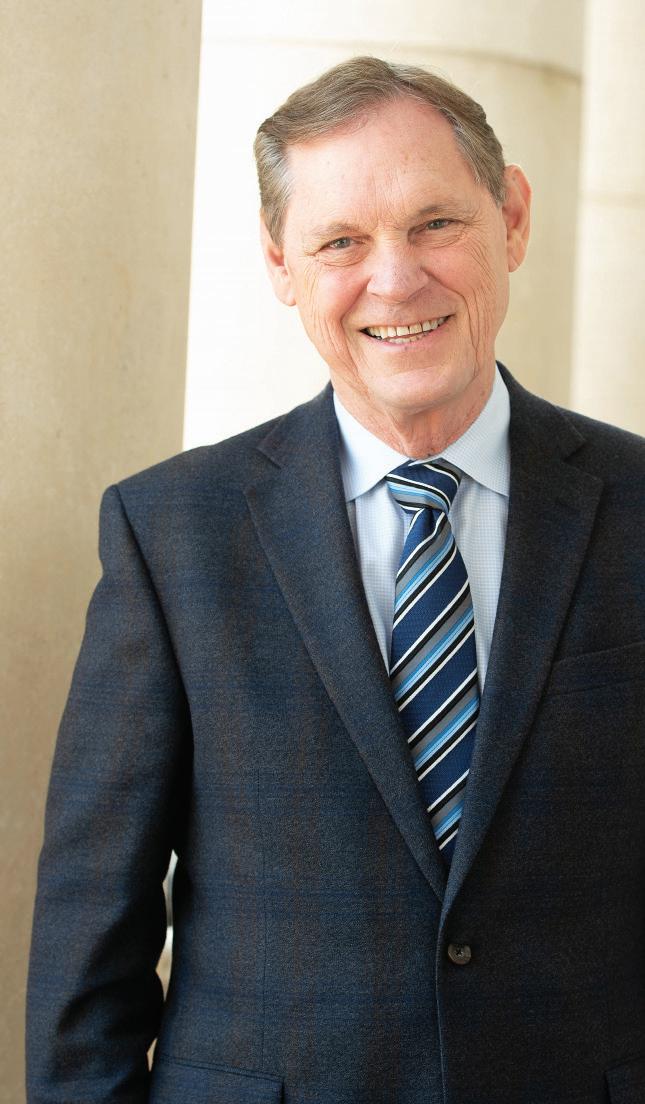

Thank you for your interest in the Hagler Institute for Advanced Study and for examining our annual report. I would like you to join me for a little thought experiment.
Let’s say you love Shakespeare’s work and are a young professor or a student seeking to specialize in his writings. Would you like to be able to discuss Shakespeare-related topics with a renowned scholar in this area? How about having access to this scholar for up to a year? Would such access likely make a diference to your career? Would you be more inspired to pursue your work, having the fnest in that feld waiting to hear what you have to say? Since professors live in the “publish or perish” world, designed to advance knowledge, would you beneft from co-authoring work with the fnest in your feld? Answering those questions inherently tells you the purpose and the impact of the Hagler Institute. The institute has, indeed, attracted the fnest Shakespeare scholar to collaborate with Texas A&M University’s faculty and students. But the institute has done the same in materials science and engineering, education, quantum science, lasers, public health, chemistry, genetics, economics, aerospace engineering, electrical engineering, mechanical engineering, astronomy, business management, autonomous vehicles, hypersonics, mathematics, wireless technology, biology, statistics, marketing, computer science and marine sciences, to name only a few subjects. For a complete list of the felds, examine the information about the fellows of the Hagler Institute for Advanced Study later in this report. In its 13 years of attracting outstanding scholars, the Hagler Institute has brought to Texas A&M 135 Hagler Fellows and 13 Distinguished Lecturers.
“It has long been my goal to bring 20 new world-class scholars to Texas A&M each year.”

Hagler Fellows come to Texas A&M for up to a year. Distinguished Lecturers were ofered the Hagler Fellow position but could only agree to collaborate at Texas A&M for up to a month.
Hagler Fellows collaborate on research with our faculty and students, resulting in peer-review publications, conference presentations, enhanced external research funding and interdisciplinary breakthroughs in knowledge. The Hagler Institute facilitates the collaboration of students with fellows by awarding fellowships for students to collaborate with Hagler Fellows, releasing these students from the necessity of fnding other support that could impair their time for learning from the fellow. To date, the Hagler Institute has funded or committed to fund 270 such student fellowships. Many graduate and undergraduate students are treated to lectures by Hagler Fellows, adding to the intellectual stimulation and guidance they already receive from Texas A&M’s outstanding faculty.
It has long been my goal to bring 20 new world-class scholars to Texas A&M each year. Over its frst 10 years, the institute averaged between nine and 10 new scholars each year. Partly due to savings that built up during the “COVID-19 era” when fellows could not visit campus and partly at the expense of the size of next year’s fellows class, in this latest year the institute brought 20 outstanding scholars to Texas A&M, including 19 fellows and one distinguished lecturer. I wanted to demonstrate to potential donors and the Texas A&M community that the
demand and capacity exist to achieve my long-term goal if given sufcient funding, erasing any doubts that people might have. The reputation of the Hagler Institute’s high standards has become suffciently wide-spread that many scholars we contact have heard of the institute and are immediately honored to have the opportunity to be a part of it.
This institute’s contribution to excellence at Texas A&M is based on the number of fellows and students the institute can support. The 2024-25 group of Hagler Fellows will be serving their time in the institute with periodic visits spread over an approximately four-year period. With such a large group of fellows to fund, in the coming years the number of fellows in each new group will be much smaller, unless additional funds can be found. It is the price of demonstrating our potential.
Hagler Fellows visits inherently provide occasions for fellows to experience the opportunities that Texas A&M has to ofer for their own careers, and they also allow Texas A&M’s faculty sufcient time to assess the advantages of having the fellow as a colleague. More than 20% of the fellows who have completed their time in the institute have joined Texas A&M’s faculty. These faculty additions continue to serve as a catalyst attracting other academy level scholars. Excellence truly breeds more excellence, if one has the resources to add very accomplished scholars and leaders to the permanent faculty. Thanks to John Sharp’s Chancellor’s Research Initiative, Greg Abbott’s Governor’s University
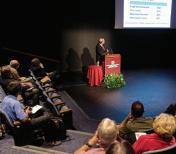
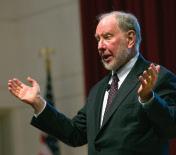
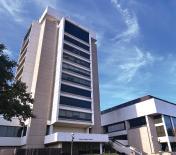
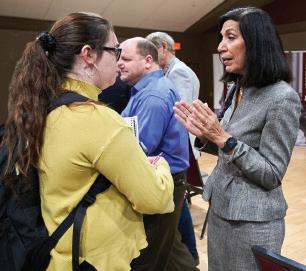
The Hagler Institute is devoted to the highest measure of academic excellence.
It is the only institute of its kind in the United States. Located in Rudder Tower in the heart of the Texas A&M campus, the Hagler Institute serves all colleges, select institutes, Texas A&M at Galveston and the School of Law in Fort Worth.
The Hagler Institute brings the world’s most notable scholars—known as Hagler Fellows— to campus for up to one year to inspire and collaborate with Texas A&M’s outstanding faculty and students.
A minimum criterion for selection as a Hagler Fellow is election into one of the national academies or having equivalent stature in other felds. In its frst 13 years, the institute has appointed 135 Hagler Fellows and 13 Distinguished Lecturers, including six Nobel Prize recipients and winners of many other prestigious honors.
Now a permanent feature on campus, the Hagler Institute was the idea of its founding director, John L. Junkins, a University Distinguished Professor in the Department of Aerospace Engineering and former Texas A&M interim president. The concept was proven over a fve-year period with startup funds provided by Chancellor John Sharp and Texas A&M’s Academic Master Plan.
A commitment of continuing funding by then-Texas A&M President Michael K. Young and supported by General (Ret.) President Mark A. Welsh lll, along with the resulting signifcant endowment provided by Distinguished Alumnus Jon L. Hagler ’58, ensures the institute’s stability.
The implications for the academic environment at Texas A&M are astounding. In
essence, each year the Hagler Institute injects new academic excellence into a variety of felds of study at the university.
The typical fellow now spends more than six months in residence, spread over three years. Within any one year, 30 or more visiting world-class scholars are commonly on the campus.
The impact of the Hagler Institute on academic excellence will advance at a pace determined by donor support and by each college or school’s participation as refected in fellow nominations.
The Hagler Institute broadly elevates the reputation of Texas A&M by:
• Connecting faculty and students with recognized scholars from across the United States and from other countries.
• Fostering advanced problem solving, research and publications.
• Increasing external research funding through eforts of current and former Hagler Fellows.
• Attracting additional world-class scholars to Texas A&M’s faculty as a by-product of their in-residence visits, some using funds from the Governor’s University Research Initiative and the Chancellor’s Research Initiative.
• Attracting new outstanding faculty and students by providing a unique intellectual atmosphere.
Each year the Hagler Institute injects new academic excellence into a variety of fields of study at the university.
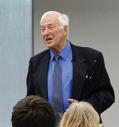

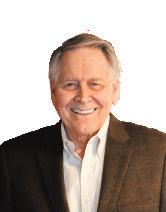
Jon L. Hagler ’58 established an endowment for the Institute for Advanced Study to secure its place as a symbol of excellence at Texas A&M University.
His devotion to Texas A&M has been evident throughout his adult life. Jon L. Hagler is recognized nationally as a leader in investment management as well as philanthropy. In 1984, he and wife Jo Ann founded the Jon L. Hagler Foundation, a private, independent foundation that has fnancially supported Texas A&M as well as multiple philanthropic eforts across the nation.
Hagler has shown an interest in supporting overarching initiatives that elevate Texas A&M’s academic stature and contribute to A&M’s long-term success. He is highly regarded and respected at the university for his leadership and contributions, both of which have spanned decades.
Texas A&M recognized Hagler with an honorary doctorate in 2015 and the 2005 Sterling C. Evans Medal for his dedication in supporting Texas A&M. He was named a Texas A&M Distinguished Alumnus in 1999 and is a past member of the board of directors of The Association of Former Students.
Hagler chaired the executive committee of the One Spirit, One Vision campaign from 2000 to 2006; co-chaired the university’s 1999 strategic planning initiative, Vision 2020: Creating a Culture of Excellence; served as past chairman and trustee emeritus of the Texas A&M Foundation Board of Trustees; and was the leading donor of the Texas A&M Foundation’s campus headquarters named in his honor.
He has ofered valuable guidance as a member of the institute’s external advisory board since its formation and through his generosity has helped make the institute a permanent part of Texas A&M. To ensure prestigious leadership in years ahead, Hagler endowed the director’s chair to provide research support for future directors of the institute. Hagler also provided matching funds that helped attract an endowment for the institute from the Robert A. Welch Foundation in 2024.
Hagler received his bachelor’s degree from Texas A&M in 1958, was a Corps of Cadets commander during his senior year, and served as a Ross Volunteer. He earned an MBA from Harvard University in 1963.
The Hagler Institute Faculty Advisory Board is charged with the responsibility of studying and analyzing the records of nominees for the Hagler Fellows, assessing their qualifcation and selecting the scholars to be recruited.
Three of the nine seats on the Advisory Board are chosen by the university’s provost and its vice president for research. The remaining six seats are chosen by the Electorate from among its members.
TERM EXPIRES MAY 31, 2025
Robert Kennicutt College of Arts and Sciences
Glynn S. Lunney, Jr. School of Law
Jörg M. Steiner College of Veterinary Medicine and Biomedical Sciences
TERM EXPIRES MAY 31, 2026
Valerie Hudson The Bush School of Government and Public Service
Stratos Pistikopoulos College of Engineering
Farida Sohrabji College of Medicine
TERM EXPIRES MAY 31, 2027
Marcia G. Ory School of Public Health
Stephen H. Safe College of Veterinary Medicine and Biomedical Sciences
Karen Wooley College of Arts and Sciences

JOHN SHARP Chancellor
The Texas A&M University System
One of my frst actions as chancellor was to seed the Hagler Institute. I believed then that the institute would attract some of the fnest professors on the planet to Texas A&M University. Now, 13 years later, I am pleased to say that it stands as one of life’s rare and glorious examples of an idea that by far has exceeded all expectations.
The Hagler Institute External Advisory Board annually reviews the activities of the Hagler Institute for Advanced Study at Texas A&M to provide guidance, advice and recommendations.
CHAIR
Ray Rothrock
Chairman, RedSeal, Inc.
Partner Emeritus, Venrock
Forbes Midas List
Former Chair, National Venture Capital Association
Member, MIT Corporation
UTIMCO, Vice Chairman
Distinguished Alumnus, The Association of Former Students, Texas A&M University
Director, Check Point Software Technology, Ltd.
Director, Roku Inc.
Trustee, Carnegie Institute of Science Director, Nuclear Threat Initiative
VICE CHAIR
Ray M. Bowen
Distinguished Visiting Professor, Rice University
Former President, Texas A&M University
Former Chair, National Science Board
Former Division Director and Deputy Director, National Science Foundation
Jon L. Hagler
Former Director, GMO
Former Chairman, Texas A&M Foundation Board of Trustees
Former Co-Chair, Texas A&M’s Vision 2020 Planning Initiative
Sterling C. Evans Medal, Texas A&M Foundation
Distinguished Alumnus, The Association of Former Students, Texas A&M University
Honorary Doctor of Letters, Texas A&M University
The Honorable
Kay Bailey Hutchison
Former U.S. Senator
Former NATO Ambassador
National Advisory Council, NASA
Global Advisory Board, Bank of America
Board of Directors, Atlantic Council
Senior Advisor, Center for Strategic and International Studies
Former Chairman, Board of Visitors, United States Military Academy West Point
Fellow, American Academy of Arts and Sciences
Ronald L. Skaggs
Chairman Emeritus and CEO, HKS Inc., Architects/Engineers/Planners
President, American Institute of Architects (AIA)
Chancellor, AIA College of Fellows
Board Chairman and Vice Chair, National Institute of Building Sciences
National Academy of Construction
Distinguished Alumnus, The Association of Former Students, Texas A&M University
Michael L. Slack
Founding and Managing Partner, Slack Davis Sanger L.L.P.
Formerly, National Aeronautics and Space Administration, Johnson Space Center
Associate Fellow, American Institute of Aeronautics and Astronautics
Distinguished Aerospace Engineering Alumni 2018, Texas A&M University
Distinguished Aggie Lawyer 2023, Texas Aggie Bar Association
Former President, Texas Trial Lawyers Association
Board of Governors, American Association of Justice
American Board of Trial Advocates
John White
Chairman Emeritus, The Texas A&M University System Board of Regents
Trustee, George and Barbara Bush Foundation
Former Chairman, Ed Rachal Foundation
Former Director, UTIMCO
Fellow, American Bar Foundation
Inductee, Texas A&M University Corps of Cadets Hall of Honor
Fifth Generation Texas Rancher
Anthony Wood
Founder, Chairman and CEO, Roku Inc.
Founder with Susan Wood, Wood Next Foundation
Technical Emmy in 2000 for creating the frst Digital Video Recorder
Technical Emmy in 2013 for creating the frst Streaming Video Player
Distinguished Alumnus, The Association of Former Students
Outstanding Alumni Award, College of Engineering, Texas A&M University
EMERITUS MEMBERS
Norman R. Augustine
Former Under Secretary, U.S. Army
Former Chair and CEO, Lockheed Martin Corporation
Former President, National Academy of Engineering
Committee Chair, Rising Above the Gathering Storm: Energizing and Employing America for a Brighter Economic Future
National Medal of Technology
University of Warwick Distinguished Lecture
Susan R. Bailey
Partner, Fort Worth Allergy and Asthma Associates
President-elect, American Medical Association
Regent Emerita, The Texas A&M University System
Distinguished Fellow, American College of Allergy, Asthma, and Immunology
Distinguished Alumna, The Association of Former Students, Texas A&M University
Former President, Texas Medical Association
Anita K. Jones
Professor Emerita, University of Virginia
Former Director, Defense Research and Engineering, U.S. Department of Defense
National Academy of Engineering
Committee Member, Rising Above the Gathering Storm: Energizing and Employing America for a Brighter Economic Future
Former Vice Chair, National Science Board
Linda P. B. Katehi
Professor, Electrical and Computer Engineering, College of Engineering, Texas A&M University
Former Chancellor, Professor of Electrical and Computer Engineering, University of California, Davis
National Academy of Engineering
American Academy of Arts and Sciences
Alexander von Humboldt Research Award
V. Lane Rawlins
President Emeritus, University of North Texas
Former President, Washington State University
Former President, University of Memphis
NCAA Board of Directors
Herbert H. Richardson
Chancellor Emeritus, The Texas A&M University System
Director Emeritus, Texas A&M Transportation Institute
University Distinguished Professor Emeritus, Mechanical Engineering, Texas A&M University
National Academy of Engineering
ASME Rufus Oldenburger Medal
Sheila E. Widnall
Institute Professor and Professor of Aeronautics and Astronautics, Massachusetts Institute of Technology
Former Secretary of the Air Force
National Academy of Engineering
American Academy of Arts and Sciences
American Institute of Aeronautics and Astronautics
Former President, AAAS
Member, Columbia Accident Investigation Board
IN MEMORIAM
H. Norman Abramson
Former Executive Vice President, Southwest Research Institute
National Academy of Engineering
American Society of Mechanical Engineers (ASME)
American Institute of Aeronautics and Astronautics (AIAA)
ASME Medal Recipient
AIAA Structures, Structural Dynamics, and Materials Award
The Hagler Institute has emerged as one of Texas A&M’s most renowned and impactful initiatives, drawing world-class scholars to collaborate with faculty and students, advancing high-level scholarship, enriching the university’s research endeavors and shaping a legacy of lasting signifcance.


GENERAL (RET.) MARK A. WELSH III President Texas A&M University
Advocates for the Hagler Institute for Advanced Study at Texas A&M champion the institute to anyone who shares an interest in the advancement of Texas A&M. In addition, Advocates identify like-minded prospective donors who may want to help establish a strong fnancial foundation for the institute’s mission.
Janice Adams
Norman R. Augustine
Miroslav Begovic
Jason A. Blackstone ’99
Ray M. Bowen ’58
Jean-Louis and Janet Briaud
Bill E. Carter ’69
Jerry S. Cox ’72
John L. Crompton ’77
Ronald A. DeVore
Edward S. Fry
Ram and Angela Galindo
J. Rick Giardino
Melbern G. Glasscock ’59
Janet A. Handley ‘76
William C. Hearn ’63
Rodney C. Hill
M. Cynthia Hipwell
Michael A. Hitt
Carl F. Jaedicke ’73
Antony Jameson
Linda P. B. Katehi
Christopher Layne
Frank Little
Karin C. Loftin
R. Bowen Loftin ’71
Carolyn S. Lohman
George J. Mann
William J. Merrell Jr. ’71
Richard and Susan Miles
Charles R. Munnerlyn ’62
Alan and Wanda Needleman
H. Joseph Newton
Gerald R. North
Erle A. Nye ’59
Elaine S. and Daniel Oran
Marcia Ory
George and Marilyn Pharr
Thomas W. Powell ’62
J.N. and Aruna Reddy
Herbert H. Richardson
Jess C. (Rick) Rickman III ’70
Mercedes Rodriguez
B. Don Russell ’70
Stephanie W. Sale
William S. Saric and Helen L. Reed
Marlan O. Scully
Les E. Shephard ’77
James M. Singleton IV ’66
Ronald L. Skaggs ’65
Michael L. Slack ’73
Christine A. Stanley ’90
Jörg Steiner
David G. and Valerie Woodcock
Karen and Mark Wooley
Stratos and Maria Zarai-Pistikopoulos
More than 20% of the fellows who have completed their time in the Hagler Institute have joined Texas A&M’s permanent faculty. These scholars are Permanent Members of the Hagler Institute, and they have been catalysts for attracting other academy-level scholars to Texas A&M’s faculty. Other National Academy scholars on the Texas A&M faculty, as well as members of the American Academy of Arts and Sciences, are Afliates of the Hagler Institute for Advanced Study.
This list refers only to those members of the congressionally mandated National Academies: the National Academy of Engineering, the National Academy of Medicine, or the National Academy of Sciences.
Kyle T. Alfriend College of Engineering
Robert Ambrose College of Engineering
Leif Andersson* College of Veterinary Medicine and Biomedical Sciences
Aristos Aristidou College of Engineering
Vanderlei S. Bagnato College of Engineering
Regan Bailey College of Agriculture and Life Sciences
Mark A. Barteau College of Engineering
Donald J. Darensbourg College of Arts and Sciences
Marcetta Darensbourg College of Arts and Sciences
Akhil Datta-Gupta College of Engineering
Luiz Davidovich* Institute for Quantum Science and Engineering
Ronald A. DeVore College of Arts and Sciences
Nancy W. Dickey Emeritus College of Medicine
Bonnie J. Dunbar College of Engineering
Ali Erdemir College of Engineering
Yassin A. Hassan College of Engineering
Dudley R. Herschbach Emeritus College of Arts and Sciences
M. Cynthia Hipwell College of Engineering
James Hubbard Jr.* College of Engineering
Antony Jameson College of Engineering
John L. Junkins College of Engineering
Linda KatehiTseregounis College of Engineering
Robert Kennicutt Jr.* College of Arts and Science
Mladen Kezunovic College of Engineering
Panganamala Ramana Kumar College of Engineering
Enrique J. Lavernia College of Engineering
David Lee College of Arts and Sciences
W. John Lee College of Engineering
Frances Ligler College of Engineering
George Ligler College of Engineering
Nathan Meehan College of Engineering
Richard Bryant Miles College of Engineering
Warren “Pete” Miller College of Engineering
William J. Murphy College of Veterinary Medicine and Biomedical Sciences
Alan Needleman* College of Engineering
Elaine S. Oran College of Engineering
Thomas J. Overbye College of Engineering
Roderic I. Pettigrew School of Engineering Medicine
George M. Pharr College of Engineering
Kenneth S. Ramos Institute of Biosciences and Technology
Junuthula N. Reddy College of Engineering
Peter Rentzepis College of Engineering
Catharine Ross College of Agriculture and Life Sciences
B. Don Russell College of Engineering
William Sage* School of Law
William S. Saric Emeritus College of Engineering
Julie M. Schoenung College of Engineering
Marlan O. Scully Institute for Quantum Science and Engineering
Rebecca A. Seguin-Fowler College of Agriculture and Life Sciences
Chanan Singh College of Engineering
Vijay Singh College of Engineering
Patrick J. Stover College of Agriculture and Life Sciences
Edwin “Ned” Thomas College of Engineering
Karen L. Wooley College of Arts and Sciences
*Hagler Institute Permanent Member The list does not include A&M faculty who are members of other prestigious U.S. or international academies. (As of January 2025: source Faculty Afairs)
FULL TIME
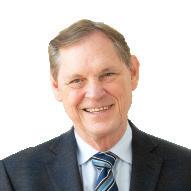
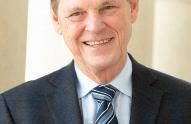
John L. Junkins Founding Director University Distinguished Professor Department of Aerospace Engineering College of Engineering
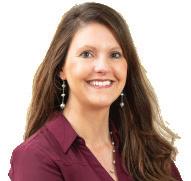
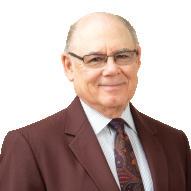
L. Fry Associate Director
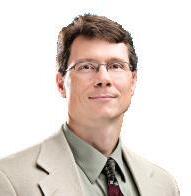
“Norm, I am establishing a new institute at Texas A&M to attract the world’s most outstanding scholars to Texas A&M for extensive collaborative visits, and I would like you to chair my External Advisory Board.
It sounds interesting. How many scholars have you brought to Texas A&M so far?
None. The institute has just been approved.
Well, how many people are on your External Advisory Board?
None yet.
You mean I am chairman of an advisory board that has no other members and for an institute that does not exist?”
Why Junkins was anxious to get Augustine to head his External Advisory Board becomes evident when you know more about Augustine. He is arguably the nation’s icon of leadership.
After graduating from Princeton University with a master’s degree in aeronautical engineering, Augustine worked for Douglas Aircraft as a research engineer, program manager and chief engineer. He served in the Ofce of the Secretary of Defense as assistant director of defense research and engineering. Augustine then joined LTV Missiles and Space Company, serving as vice president for advanced programs and marketing. He returned to the government with the U.S. Army as assistant secretary for research and development, culminating his government service as Secretary of the Army.
Joining Martin Marietta corporation as vice president of technical operations, Augustine rose to become president, then chief operating ofcer, CEO, and fnally chairman. He then served as president and CEO of Lockheed Martin Corporation. In his mid-60s, He retired as chairman and CEO of Lockheed Martin and joined the faculty at Princeton University. His volunteer service since his so-called retirement has been truly remarkable. Augustine has served as chairman of the Council of the National Academy of Engineering,
chaired the Aerospace Industries Association and the Defense Science Board, and served as president of the American Institute of Aeronautics and Astronautics.
He also devoted his time to be president of the Red Cross. He led several impactful studies by the National Academy of Sciences, including the “Rising Above the Gathering Storm” study.
Augustine served as a regent of the University System of Maryland, is a trustee of The Johns Hopkins University, and is a former member of the Board of Trustees of Princeton University and the Massachusetts Institute of Technology.
Augustine has served on many industrial boards and has advised the U.S. departments of Homeland Security, Energy, Defense, Commerce,Transportation and Health and Human Services, as well as NASA, Congress and the White House.
In addition to being a member of the National Academy of Engineering, Augustine is a member of the American Philosophical Society, the National Academy of Sciences, and the Council on Foreign Relations and is a fellow of the National Academy of Arts and Sciences and the Explorers Club.
The impact of Augustine’s leadership, dedication, and vision has been extremely important to the Hagler Institute. His reputation helped Junkins attract other great people for his External Advisory Board, and his leadership helped guide the development of the Hagler Institute for Advanced Study.
For Augustine’s willingness to take a gamble on tying his name to an institute that was then only a novel idea, and for his subsequent devotion to the institute’s development, the Hagler Institute awarded Norman R. Augustine its frst “Take Flight Leadership Award.”

The Hagler Institute for Advanced Study is a beacon of excellence at Texas A&M University.
Each year, the Hagler Institute attracts a new group of world-class scholars, called Hagler Fellows, who stay from three to 12 months on the Texas A&M campus, and Distinguished Lecturers, who come for shorter visits.
That annual infux of talent enriches Texas A&M’s intellectual atmosphere, enhances the quality of academic programs, accelerates solutions to complex research problems, assists in external research funding, and heightens Texas A&M’s reputation as a top-tier research university. Like a ripple in still water caused by a stone’s throw, the presence of the Hagler Fellows provides inspiration that permeates through the participating departments, colleges, schools, and institutes and afects all the students who collaborate on research with these top scholars or hear their lectures.
Another hallmark of a great university is that renowned scholars at other universities want to interact with its faculty and students. The Hagler Institute has proven an important magnet for such engagement at Texas A&M.
During their time on campus, Hagler Fellows collaborate in intense research with Texas A&M’s internationally known senior faculty and rising-star junior faculty. Furthermore, the Hagler Institute provides two graduate student fellowships per fellow to ensure that Texas A&M’s top students have the opportunity to team with Hagler Fellows and their university hosts in meaningful research. These associations can fundamentally enhance students’ career options.
In their host colleges or schools, Hagler Fellows often present lectures that reach a broad audience.
In addition, the Hagler Institute for Advanced Study chooses one fellow each semester to present its public Eminent Scholar Lecture.
Although the institute is not designed to recruit permanent faculty, the time in residence gives Hagler Fellows a valuable look at the opportunities and research facilities of this great institution. Since its inception, more than 20% of the Hagler Fellows who completed their time in the Hagler Institute joined Texas A&M’s permanent faculty. Each of these fellows represent the cream of the crop of potential faculty additions. Such distinguished faculty in turn attract other outstanding scholars. Since the Hagler Institute’s frst class arrived in fscal year 2013, the number of members of the congressionally mandated National Academies of Engineering, Medicine and Sciences on Texas A&M’s faculty has increased from 11 to 54. This remarkable infux of talent has helped make Texas A&M the frst academic institution in Texas to attain more than $1.1 billion in research expenditures in a fscal year.
Within the addition of fellows to engineering faculty lies a unique success story. Alan Needleman, a 2012–13 fellow and one of the world’s most cited scholars, joined Texas A&M’s faculty upon completing his work in the Hagler Institute. The College of Arts and Sciences and the College of Engineering joined forces to form a new Department of Materials Science and Engineering with Needleman as its most distinguished faculty member. He was soon joined by new hires of top professors, including George Pharr, another noted researcher and member of the National Academy of Engineering. Renowned scientist and engineer Edwin “Ned” Thomas later joined the faculty of that department after initially being attracted to the Hagler Institute for Advanced Study while at Rice University. These three highly
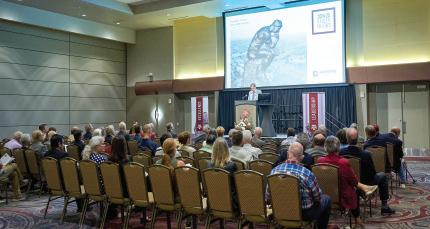
accomplished individuals were hired into either a Chancellor’s Research Initiative (CRI) position or a Governor’s University Research Initiative (GURI) position. Each CRI and GURI position came with two additional faculty positions and startup funds of about $5 million. These three National Academy of Engineering hires were instrumental in advancing the new department from startup to national and international prominence.
The Hagler Institute has paid for itself many times over. Its excellence mission has attracted signifcant donor contributions. In addition, funds have come to Texas A&M due to former fellows who joined Texas A&M’s faculty and other new professors attracted to Texas A&M because of these additions. These funds have come from the CRI, the GURI and increases in outside research funding.
Christodoulos Floudas, a former fellow of the Hagler Institute and a renowned chemical engineer from Princeton University, joined Texas A&M’s faculty, and in February 2015 became the director of Texas A&M’s Energy Institute. Floudas recruited Stratos Pistikopoulos, a member of the Royal Society in the United Kingdom, and together they rebuilt Texas A&M’s Energy Institute into a vibrant asset. Before Floudas’ sudden death in August 2018 at 56, the two attracted more than $20 million in new research funds. Since then, under Pistikopoulos’ leadership, the Energy Institute has been awarded more than $45 million through projects sponsored by the U.S. Department of Energy, the National Science Foundation, the National
The Hagler Institute has paid for itself many times over. Its excellence mission has attracted significant donor contributions.

Institutes of Health, the U.S. Department of State and other sources.
Top faculty and funding are combined with top students at the fnest universities. Adding more of the nation’s most outstanding students to Texas A&M’s graduate programs will enhance excellence at Texas A&M University. Adopting an idea from John Junkins, Chancellor John Sharp has committed funds to a new Chancellor’s National Academy STEM (Science, Technology, Engineering, Mathematics) Ph.D. Fellowships program with that objective, starting with certain felds of study. Although the funds are not available for Hagler Institute objectives and functions, the Chancellor not surprisingly chose the Hagler Institute to design and administer this program. The program requires qualifed candidates to have a 3.9 or better out of a 4.0 grading system as an undergraduate, even if they are already earning or have a Master’s degree. The student must also team with a Texas A&M University faculty member who is also a national academy member, as well as team with a “rising star” faculty member. This competitive program pays $40,000 per year to the student for a guaranteed four years, plus tuition, university fees and cost of health insurance for the four years.
Because the Hagler Institute is administering the new Chancellor’s Fellowship program, we will know all students involved, and we look forward to connecting them with visiting Hagler Fellows. The Hagler Institute is helping Texas A&M in its climb to the top of public universities in the nation.
SCHOLARS IN THE FIRST 13 CLASSES HAVE CHOSEN TO JOIN TEXAS A&M’S PERMANENT

Harold Adams RKTL International College of Architecture

Luiz Davidovich Federal University of Rio de,Janeiro, Brazil Institute for Quantum Science and Engineering

Roger Howe Yale University College of Education and Human Development

Rachel Moran University of California, Los Angeles School of Law

William M. Sage University of Texas at Austin College of Medicine School of Law

Robert Skelton University of California, San Diego College of Engineering

Leif Andersson Uppsala University, Sweden College of Veterinary Medicine and Biomedical Sciences

Vanderlei Bagnato University of São Paulo, Brazil College of Engineering


Christodoulos Floudas Princeton University College of Engineering, Energy Institute

Karl Hedrick University of California, Berkeley College of Engineering


James E. Hubbard Jr. University of Maryland College of Engineering

Alan Needleman University of North Texas College of Engineering


Robert Kennicutt Jr. University of Cambridge, England College of Arts and Sciences

Jean-Paul Rodrigue Hofstra University Texas A&M University at Galveston


Edwin “Ned” L. Thomas Rice University College of Engineering


William G. Unruh University of British Columbia, Canada Institute for Quantum Science and Engineering
AMERICAN INSTITUTE OF ARCHITECTS
2
WOLF PRIZE
12
NATIONAL ACADEMY OF MEDICINE

42
INTERNATIONAL ACADEMIES

6 NOBEL PRIZE


43
AMERICAN ACADEMY OF ARTS AND SCIENCES

1
N AT I O NA L ME DA L OF S CI E NC E
2
2
AT IONAL AC AD E MY OF SCIENCES N AT IONAL HUMANITIES MEDAL
ACADEMY AWARD
STATE PRIZE OF RUSSIA
NATIONAL MEDAL OF TECHNOLOGY AND INNOVATION

50
NATIONAL ACADEMY OF ENGINEERING
1
HUBBELL MEDAL IN LITERARY SCHOLARSHIP
39
1 1 1 1
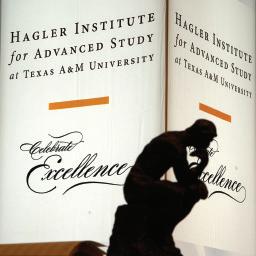
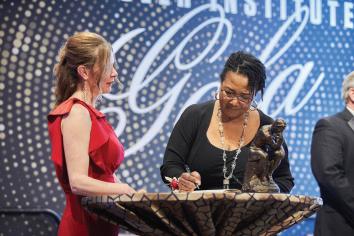
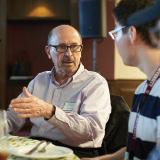
Hagler Fellows go to their respective departments to collaborate with faculty and students in their discipline. Those of us at the Hagler Institute enjoy meeting and getting to know all the fellows.
The Hagler Institute and the colleges, schools and institutes (hereafter referred to as colleges) share in the costs of the fellows. The Hagler Institute pays 70% of each fellow’s stipend and provides two one-year fellowships for students to work on research with this visiting scholar. The nominating college and department commit to fund travel and housing expenses plus 30% of the fellow’s stipend, as well as provide a discretionary fund for research expenses.
The selection process is as fair as we can make it. The Hagler Institute allows each college fve and a half nominees, regardless of the size of the college. The half nomination represents a multidisciplinary nominee for whom two colleges share costs. The Hagler Institute allows those colleges with endowments devoted to supporting Hagler Fellows one additional nomination slot for each such endowment.
The Hagler Institute invites all faculty members to consider their choice of a top scholar, not at Texas A&M, with whom they would like to work. Nominations are confdential. The nominees are not informed of their nomination unless they are selected. Department heads and deans determine which nominations are sent to the Hagler Institute for evaluation as potential Hagler Fellows.
Selection of fellows of the Hagler Institute is a multiyear process. Our nomination period opens in April and concludes in August, allowing the deans and faculty sufcient time to assess nominees. The Hagler Institute’s Faculty Advisory Board is charged with completing its evaluations of the nominees by late November or early December. Most of the recruiting of the fellows then takes place in January through August of the following year.
The Faculty Advisory Board carefully reviews and evaluates the nominees based on excellence criteria. The fundamental questions are:
1. Is the nominee of National Academy stature in their feld?
2. Is the nominee currently active as a leader in their feld?
3. Is the nominee a strong mentor?

To assist in the assessments, Associate Director Amanda Scott provides information – typically a 20-page dossier – about each nominee. She prepares detailed analyses of the nominee’s refereed publication data and citations, the nominee’s three most recent publications and the three most cited publications. This helps the Faculty Advisory Board assess the nominee’s impact on the literature and how active they are in their current scholarship. Scott conducts a historical protégé and mentorship assessment that includes teaching and mentoring awards, as well as documented research collaboration with current and former students. She provides each member with a sheet for scoring nominees. The photo shows the packet she provided in fall of 2024 to each Faculty Advisory Board member for their use in evaluating the nominees for the upcoming 2025-26 class of fellows.
The evaluation process is a serious endeavor. As Junkins conveys to the Faculty Advisory Board, “We are like academic venture capitalists spending money from other people who trust us. Let’s get this right.”
Junkins does not advocate for or against a nominee and cannot vote for approval or disapproval of any nominee. The Faculty Advisory Board members score each nominee from one to four, providing for the rank ordering for recruiting. Any nominee receiving an average of two or above is approved for recruiting. Junkins makes recruiting calls starting in December and continuing through the early months of the following year.
The recruitment process begins with calls from Junkins informing the scholars that they have won a contest that they did not know they were in. He explains the honor of being chosen for the Hagler Institute and shows the exclusive group of prior fellows with whom the nominee will be associated. Junkin’s call is followed by one from the nominating college, typically the dean. Associate Director Cliford Fry assists with negotiations and preparation of fellow agreements.
News about the Hagler Institute has now sufciently spread that most scholars are aware when contacted of the honor of being chosen for the institute. Additionally, many know faculty at Texas A&M and look forward to the collaborations. Given the people in many departments with whom the Hagler Institute staf must work during the recruiting process, along with the busy schedules of prospective fellows, recruitment is usually on-going through August despite the early start.
Table 1 provides a history of the nomination, approval and recruitment of Hagler Fellows by year, for fscal years 2013 through 2025. Over this 13-year period, a total of 260 scholars were nominated. The
* This table reports nomination, approval, and recruitment data by the fscal year in which the corresponding announcement of Fellows takes place. The fscal year begins September 1. Fiscal year 2013, for example, extends from September 1, 2012 through August 31, 2013. In the fall of each year, the Hagler Institute announces a new class of Fellows. The process of nominating, approving, and recruiting potential Fellows, however, begins more than a year prior to the announcement. The nomination process for the FY25 class of Fellows announced in fall 2025, for example, began in spring 2023.
** Some Fellows cannot accept a Hagler Institute appointment in the year for which they are frst nominated and approved, but instead accept in a later year. This column reports the number of the current year’s approved nominees who are successfully recruited as Fellows in any year.
*** This column reports the number of Fellows announced in the current fscal year, regardless of when the Fellows were originally nominated and approved.
Faculty Advisory Board deemed 229 (88%) of these nominees to meet the high standards required for fellows and approved them for recruiting. Of the 229 approved nominees, the institute successfully recruited 135 (59%) as fellows.
Tables 2 and 3 further depict select data from Table 1. Table 2 shows the percentage of each year’s approved nominees which are successfully recruited, with an average of 58% and a high of 76% for fscal year 2025.
Table 3 shows the number of fellows announced each fscal year. The count reached a high of 19 in fscal year 2025, an encouraging indication of the institute’s potential to reach its goal of 20 new fellows per year given sufcient resources.
The Hagler Institute has already received nominations for the fscal year 2026 group of fellows. These nominations are currently under review. Table 4 reports the nomination count by college.
The Hagler Institute advances the Texas A&M research enterprise by fostering collaboration between distinguished Hagler Fellows and our leading faculty to address global challenges, mentor emerging scholars and expand knowledge across disciplines. Through its support of pioneering research, the Institute strengthens the university’s contributions to progress and innovation.


The Hagler Institute awards two one-year fellowships per Hagler Fellow to students so they can team with that Fellow without other work responsibilities .
Sometimes, instead of two students receiving a fellowship, one student receives the fellowship for a two-year period, allowing collaboration with the Hagler Fellow whose visits are spread over multiple years. Such a student is Caleb Shackelford, who has been working with Donald L. Sparks, a Hagler Fellow in the 2022-23 class.
Here is what Shackelford wrote to the institute about the importance of receiving his fellowship. “I am incredibly grateful for my time with the Hagler Institute, as it has exceeded all my expectations. Dr. Sparks, who is my mentor, embodies exceptional intelligence, humility and kindness, which makes it a true honor to be
under his mentorship. The generous funding provided by the institute has enabled me to wholeheartedly pursue my aspirations of becoming an accomplished scientist without the need for external employment, which is a unique and invaluable opportunity. I genuinely believe that this institution has empowered me to strive for greatness, and my frst semester has only further confrmed this belief. I am blessed to be a part of the Hagler Institute.”
Shackelford is, indeed, fortunate to be in the company of Sparks. Sparks, a fellow of the American Society for the Advancement of Science, is the Unidel S. Hallock du Pont Chair and Francis Alison Professor in the Department of Plant and Soil Sciences at the University of Delaware. Sparks has published over 300 peer-review journal articles, has written three books and been editor of numerous volumes of Advances in Agronomy. For three years he chaired the U.S. National Committee on Soil Science for the National Academy of Sciences. His research has been honored with awards, including the Geochemistry Medal from the American Chemical Society and the Pioneer in Clay Science Award from the Clay Minerals Society. In his Hagler Fellow appointment, Sparks is collaborating with faculty and students in the Department of Soil and Crop Sciences in Texas A&M’s College of Agriculture and Life Sciences, where he met fellowship student Shackelford.
During their frst year they worked together on “…soil aggregate formation and carbon sequestration via root exudation in drought conditions. Root exudation refers to the phenomenon where plants release various molecules through their root systems, thereby modifying the soil environment to better suit their requirements… the objective of our research is to investigate root exudation processes during drought to determine its impact on mineral associated carbon formation and soil aggregation, as well as ascertain whether recalcitrant carbon is being generated or simply broken down and converted back into CO2 by microbes”
The research has potential implications for those interested in long-term carbon storage.
BY HAGLER FELLOWS

‘HAMLET’ IN THE DIGITAL AGE

THE BOX THAT MAKES THE WORLD GO ROUND

MEDICAL TECHNOLOGY AND AI
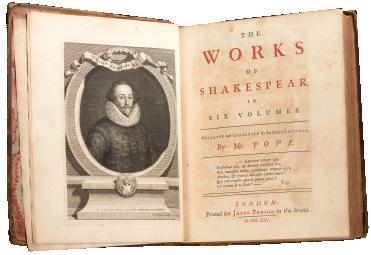
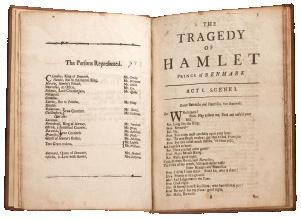
But when Hamlet kills Polonius, mistaking him for Claudius, Claudius realizes that Hamlet is dangerous to him and dispatches him to England with an order for his execution. Hamlet arranges for the courtiers Rosencrantz and Guildenstern to be killed in his place and returns to seek retribution.
All these plot elements originated in the legend of “Amleth” from the “Gesta Danorum,” a history of Denmark written in Latin around the year 1200 by Saxo Grammaticus. But while Saxo’s Amleth lived on to have other adventures, Shakespeare’s Hamlet does not survive his revenge. Unlike Amleth, Hamlet does not feed the body of Polonius to pigs. Shakespeare created other spectacular scenes, including visitations by the ghost of Hamlet’s father, a re-enactment of his father’s murder by a group of traveling actors and the report of Ophelia’s drowning death.
In 1570, Amleth’s tale was retold in French by François de Belleforest, who made his tragic hero more self-doubting, troubled that he was not swifter to enact retribution. In his own voice, as narrator, Belleforest questioned the morality of revenge. Here, you will recognize the troubled conscience of Shakespeare’s Hamlet. Shakespeare developed the theme by giving Hamlet a confdant, Horatio, and by adding two men of action, Fortinbras,
prince of Norway and Laertes, son of Polonius. For Hamlet, the comparisons were iniquitous.
Shakespeare’s genius, however, was to locate the story’s ethical debate not in other characters, not in a narrator, but in the person of Hamlet himself. The voice we hear throughout the play is his, speaking in soliloquy. What, he asks us even as he asks himself, is the meaning of life? Can earthly justice redeem fatal injustice? Is it evil to avenge evil? How do we survive the consequences of our actions and inactions?
Some 40 years before René Descartes declared “Cogito, ergo sum” – “I think, therefore I am” – Hamlet invited us to engage with his innermost thoughts. He became the avatar for what we still identify as personhood.
If you have read “Hamlet,” you have read just one of many versions of “Hamlet.” Every editor cobbles together a diferent “Hamlet” from among three early versions of the play.
After Shakespeare’s death in 1616, his colleagues gathered the scripts for thirty-six plays in a book known as the First Folio, for its large (“folio”) size. About half the plays had already been printed during
Shakespeare’s lifetime, in smaller, paperback-sized quartos. ”Hamlet” appears in a quarto of 1603 (Q1), a quarto of 1604-05 (Q2) and the Folio of 1623 (F).
Behind each printed version of the play, there will have been a handwritten version from which type was set, but none of these survive. There are no authorial manuscripts for any of Shakespeare’s works.
Q1, AT 15,983 WORDS, IS THE SHORTEST OF THE THREE.
The title page indicates that this “Hamlet” was performed in London, Cambridge and Oxford – and it includes some vivid stage directions for movement and costuming. The ghost of Hamlet’s father enters in full body armor; only in Q1 does he later change into a dressing gown. But Q1’s Polonius is called “Corambis,” and many lines seem garbled. In Q1, “To be, or not to be, that is the question” appears as, “To be or not to be; aye, there’s the point.” One school of thought is that Q1 is Shakespeare’s frst draft. Another is that Q1 was pirated, recreated from an actor’s best memory of the script behind Q2.
Q2 IS THE LONGEST VERSION, WITH 28,628 WORDS.
In a direct challenge to Q1, it declares that it is “newly imprinted and enlarged to almost as much again as it was, according to the true and perfect copy.” It is the only text to give Hamlet seven soliloquies.
F HAS 27,602 WORDS BUT IS NOT A LIGHTLY EDITED VERSION OF Q2.
While F omits one of Q2’s soliloquies, it includes 1,914 words that are not in Q2. Among them is Hamlet’s famous observation that “Denmark’s a prison.” F was based on a diferent manuscript than that used for Q2, with only 220 of Q2’s original lines being identical to those in F, highlighting the distinct textual variations between the two versions.
Believing that all three versions are fawed, editors set out to make their ideal “Hamlet.” Most start
with Q2 as their base version, or “copy text,” because they don’t want to give up any of those signature soliloquies. They will add in material that is unique to F because they can’t bear to lose “Denmark’s a prison.” They may adopt Q1’s description of the ghost’s dressing gown. The result is a “confated” text, giving you as much “Hamlet” as possible.
TIME READ OR SAW THE VERSION OF “HAMLET” THAT YOU KNOW TODAY.

Confation fattens out diferences among the three versions. Q1 has enjoyed the least editorial traction, in part because just two printed copies survive, and these were undiscovered until 1823 and 1856. But Q1 gives us a very diferent Gertrude from the underwritten, ambiguous character we encounter in Q2 and F. Rather than switching her allegiance to her new husband Claudius in a vacuous and oblivious way, she enjoys a scene with Horatio in which she shows herself to be actively supportive of her son. You will not fnd this Gertrude in modern confated editions.
Editors make the plays easier for us to read. They break the text into acts and scenes and indicate when characters enter and exit. They modernize spellings, capitalization and punctuation. They regularize the “speech headings” that tell us which characters are speaking.
Take a notorious example from “Romeo and Juliet,” where a single character is identifed in one scene as “Wife,” “Old La.” (for “Old Lady”) and “Mo.” (for “Mother”); in another scene as “Ca. Wi.” (for “Capulet’s Wife”); and in a third scene as “La.” (for “Lady”), “Mo.” (for “Mother), “M.” (for “Mother”) and “Wi.” (for “Wife”). It is a relief to read a modern edition where she is always “Lady Capulet.”
plays, only one of which, “Hamlet,” required two volumes to document its complex textual history.
In 1933, the New Variorum series was adopted by the leading professional organization for American scholars of literature, the Modern Language Association (MLA), which published a few more NVS editions. By the 2010s it had become obvious the project could not sustain itself in print media. For “Hamlet,” for example, an NVS edition must compile emendations made by more than 200 editors over more than 300 years. If the Furnesses had had the technological capacity, they would have worked through hyperlinks rather than footnotes, because nearly any word in any Shakespeare play can lead to a world of editorial interpretation.
The task of digitizing the NVS was too extensive for the MLA to manage. In 2017, the MLA assembled a working group to determine the project’s future, which I chaired. The group included professors Matt Cohen (University of Nebraska), Julia Flanders (Northeastern University), Alan Galey (University of Toronto) and Valerie Wayne (University of Hawai’i), representing expertise in digital scholarship, Shakespeare editing and humanities project development.
Working with the NVS general editors, professors Eric Rasmussen (University of Nevada, Reno) and Paul Werstine (University of Western Ontario), we chose to partner with Texas A&M’s Center of Digital Humanities Research, then led by Professor Laura Mandell.
Today, the NVS is housed at the Texas A&M English department, where we hope its success harnessing Shakespeare scholarship will lay out pathways in pioneering digital research for other Texas A&M faculty and students working on other authors. At our website (newvariorumshakespeare.org), you will fnd the NVS up and running. “Hamlet” is still in progress, so you won’t yet have the chance to click on “sallied” and decide whether to follow Nicholas Rowe to “solid” or John Dover Wilson to “sullied.”
But there are countless other instances in which the work editors do to help us read Shakespeare are acts of interpretation of Shakespeare, some small, some as big as the question of Gertrude’s character, and all discoverable in our pioneering digital editions. At present, you can see where a variorum will take you for “A Midsummer Night’s Dream” and “The Winter’s Tale.”

A A LER ELLO
RO T E CLASS
O 202 22 LENA
CO EN ORL N S
A RENA SSANCE
L TERATURE
SC OLAR
SPEC AL N N S A ESPEARE
PRO ESSOR E ER TA AT
EOR ETO N UN ERS T AN
OR ER E ECUT E RECTOR
O T E OL ER NST TUTE AN
S A ESPEARE ASSOC AT ON O
A ER CA A ELLO O T E
RO AL STOR CAL SOC ET S E
AUT ORE T E PR ATE L E O
LL A S A ESPEARE LEN N
L TERATURE STOR AN ARC AL
RESEARC ORL N AS RECE E
PREST OUS ELLO S PS AN
SER ES AS E TOR OR A OR
S A ESPEARE SER ES ER OR
R ES SC PL NES S AP N
O ERN UN ERSTAN N O
S A ESPEARE S L E AN OR S

BY JEAN-PAUL RODRIGUE HAGLER FELLOW 2022-23
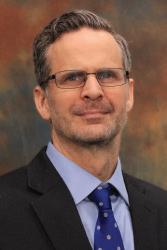
The growth of trade and commerce has been substantial in the last half century, particularly since the entry of China into the global manufacturing landscape in the early 1990s. Export-oriented economies such as China could not exist without the transport and logistical capabilities ofered by containerization. Evidence underlines that the container may have been responsible for the most signifcant factor in the growth of global trade, far exceeding the benefts accounted for by trade agreements and other trade facilitation measures such as information technologies. Containerization is a standardization of transport and cargo handling practices that allowed for the fourishing complexity and diversity of trade relations through a combination of lower costs and increased cargo velocity. Ships, ports and freight distribution systems have been built around the container through an infrastructureheavy path dependency. There have been so much accumulated
capital investments around the container that it has become virtually impossible to set another standard for trade and shipping.
As containerization is reaching a phase of maturity and widespread difusion, it continues to experience ongoing growth with the occasional setback related to large economic and geopolitical events such as the fnancial crisis of 2008-09, the COVID-19 pandemic of 202021 and the recent Red Sea Crisis (2023-present). The big picture is revealing. It was estimated that 866 million Twenty-Foot Equivalent Units (TEUs) were handled by container ports in 2023, up from 692 million in 2015 (25% growth). For the United States, this fgure was 55 million TEUs in 2023, up from 47 million in 2015 (17% growth). Houston saw its trafc jump from 2.1 million to 3.8 million TEU during the same period, an 81% surge. The latter is mainly attributed to the expansion of the Panama Canal in 2016, allowing for larger containerships servicing East Asian trade routes to call the East and the Gulf coasts.
Containerization relies on an extensive network of container terminals that act as distribution platforms between markets. Although they are mainly designed to handle a single commodity, the container, they carry an impressive variety of goods and commodities. Each container may look exactly the same, but inside the box, a multiplicity of unrelated supply chains converge at terminals. For Houston, the retail goods that account for a large share of the inbound cargo have nothing in common with the resins and plastics accounting for the bulk of containerized exports. The only commonality is the container, which is used as a load unit to support logistical and distribution capabilities. An analogy would be the individual passengers on a fight using airports as points of origin and destination, but each for a diferent reason.
Ongoing growth puts pressure on container terminal operations, which are fow-based structures involving three main components.
On the pier side, container terminals must accommodate larger ship sizes with their draft requirements. A standard containership now requires a draft of around 50 feet. There is also the issue of throughput and turnover, where enough cranes must be available to handle the unloading and loading process, often within less than 24 hours. Pier-side infrastructure and equipment are highly capital-intensive.
The container yard is the most spaceintensive component, where trafc growth must be accompanied by growth
in the availability and density of storage space. The yard acts as a bufer in supply chains, reconciling maritime and inland circulation systems. On the maritime side, a large containership can easily require the handling of 3,000 TEUs during a port call, which requires the equivalent of three hectares of yard space. On the land side, trucks deliver and pick up individual containers on a constant basis during terminal operating hours. If the facility has an on-dock rail yard, unit trains of around 400 TEUs each can be assembled. As containerships are getting bigger, there is a growing discrepancy between the modal capacity in maritime and inland transportation systems, underlining the strategic importance of container terminals as bufers in global supply chains.
The gate is the entry and exit point for a container terminal where each container must be tallied and tracked. Some facilities can generate around 25,000 truck moves per week, with each move resulting in a container to be picked up or dropped at the yard.
Figure 1 is particularly illustrative of the enduring pressure that container terminals have been facing for the last 50 years as new classes of containerships were recursively introduced. There has been a stepwise process that accelerated in the 1990s with the deployment of ships beyond the specifcations of the Panama Canal. Since then, each step has involved a substantial growth of containership capacity, tripling in 20 years and reaching a threshold of 24,000 TEUs in 2018 when Ultra Large Containerships (ULCS) of the “Megamax”

25%
It was estimated that 866 million Twenty-Foot Equivalent Units (TEUs) were handled by container ports in 2023, up from 692 million in 2015.
For the United States, this fgure was 55 million TEUs in 2023, up from 47 million in 2015.
17% GROWTH GROWTH
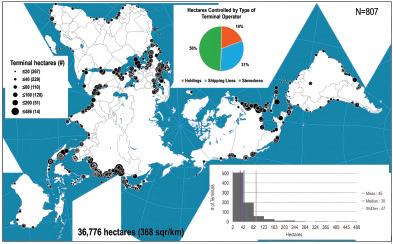

port sites, draft and available land (Figure 3). The matter is to make a series of rectangular container stacks ft the available footprint, which can lead to original designs and adaptations.
Building and expanding new terminal facilities, particularly in advanced economies, is becoming uncommon. Options and land are scarce and prone to controversy, notably concerning environmental impacts on coastal ecosystems. Under such circumstances, there is an ongoing push toward increasing levels of terminal automation, which is transformative and disruptive, often sparking labor conficts. Still, the container terminal is an essential footprint requiring careful consideration as an element of the national economic fabric. This footprint is a price to pay to enable global trade and the wide variety of goods and resources it provides.
Further Readings
Levinson, M. (2006) The Box: How the Shipping Container Made the World Smaller and the World Economy Bigger, Princeton: Princeton University Press. http://dx.doi.org/10.2307/20032089
Levinson, M. (2020) Outside the Box: How Globalization Changed from Moving Stuf to Spreading Ideas, Princeton: Princeton University Press. http://dx.doi.org/10.1007/s13437-022-00265-3
Notteboom, T., A. Pallis and J-P Rodrigue (2022) Port Economics, Management and Policy, New York: Routledge. https://doi.org/10.4324/9780429318184
Rodrigue, J-P (2024) The Geography of Transport Systems, Sixth Edition, New York: Routledge. https://doi.org/10.4324/9781003343196
RO R UE S A
PRO ESSOR N
T E EPART ENT O AR T E US NESS

A N STRAT ON AT TE AS A UN ERS T AL ESTON AN A A LER ELLO CLASS O 2022 2 A LEA N E PERT N
TRANSPORT EO RAP E
AS PU L S E NU EROUS N LUENT AL OR S NCLU N
T E EO RAP O TRANSPORT
S STE S AN PORT ECONO CS ANA E ENT AN POL C E
RAN S A ON T E TOP 2 O C TE SC OLARS LO ALL AN AS A SE NTERNAT ONAL OR AN AT ONS EARN N
T E 20 E AR L ULL AN A AR OR CONTR UT ONS TO TRANSPORT EO RAP
BY KYLE J. MYERS HAGLER FELLOW 2023-24
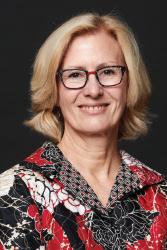
Recent advances in computing power and the widespread availability of artifcial intelligence (AI) algorithms have enabled rapid acquisition and processing of vast amounts of data and the very real potential for development of a metaverse for intelligent healthcare. A metaverse of ‘Medical Technology and AI’ (MeTAI) can facilitate the development, prototyping, evaluation, regulation, translation and refnement of AIbased medical practice. How then to determine when such nascent tools are ready for prime time?
Image Science provides a framework for the objective, or task-based, assessment of medical imaging systems and the quality of the data they produce. This framework has been used to support the evaluation
of medical imaging system hardware, image reconstruction and other image processing methods (including artifcial intelligence and machine learning), and display devices by academia, industry, and FDA. As medical imaging systems have become more complex the stateof-the-science for image quality assessment has similarly advanced to meet current challenges in the design, regulatory approval and clinical translation of such systems. Key among these advances is the use of virtual clinical trials or in silico assessments of medical imaging technologies.
“Image Quality” has an intuitive meaning for most of us. A better photo taken on our cameras or


mobile devices is less noisy, or perhaps sharper so that fner details are clear. First in flm-based photographic imaging, then in defense applications for surveillance, later in the television world, and subsequently in medical imaging, measures of image quality were developed to quantify such imaging system characteristics as noise, contrast, resolution, and dynamic range. Drawing from concepts developed by electronics engineers in communications, medical imaging scientists and clinicians came to appreciate that such technical measures of image properties can be combined into task-based fgures of merit that summarize the quality of an imaging system in terms of its ability to support medical decisionmaking. In short, a better medical imaging system is one that supports improved inferences derived from medical images, e.g, improved disease detection and classifcation, treatment planning, or patient follow-up to assess treatment efectiveness.
Figure 1 lays out a medical imaging pipeline, including the subject being imaged, the imaging system hardware, any image reconstruction or image processing steps, and fnally the interpretation of the image by an observer. In modern times, artifcial intelligence (AI) may play a role in any of the imaging steps in the fgure. The imaging hardware can be tuned with the support of AI, as is the case for the Caption Health system that assists ultrasound (US) sonographers in fnding the best orientations for
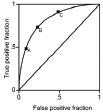
U.S. transducers when imaging the heart. Many AI-enabled image processing algorithms are on the market in the United States that reduce noise in images acquired with lower radiation dose, so as to enable reduced patient exposure to radiation while not compromising diagnostic quality. The longest record of AI in medical imaging, dating back to the 1990s, belongs to the feld of computeraided diagnosis (CAD), in which algorithms assist radiologists, pathologists, or other clinicians in the detection of cancers or other abnormalities in the brain, breast, colon, lungs, and even pathology specimens. These are just a few examples across the hundreds of AI-enabled medical imaging devices now on the market in the U.S. In each of these examples the U.S. Food and Drug Administration required clinical data demonstrating that a reader’s ability to detect the target or disease of interest with AI was improved over a reader’s performance without that AI system. The “quality” of the AI-enabled imaging pipeline was improved in a task-based sense.
Task-based evaluation of an imaging system thus requires the specifcation of all the elements in the pipeline shown in Figure 1: the subjects being imaged, the components of the imaging system, the readers, and the task. In the sections that follow we discuss advances in computational methods for assessing medical imaging systems in silico intended to facilitate the task-based evaluation of imaging
systems, including AI-enabled medical imaging devices. These advances are bringing us ever closer to the possibility of realizing rigorous, predictive task-based assessment studies of medical imaging systems without humans in the loop either as patients in a clinical study or as image readers. Ultimately, a metaverse of ‘Medical Technology and AI’ (MeTAI) based on these tools can facilitate the development, prototyping, evaluation, regulation, translation and refnement of AI-based medical practice.
Arguably the most challenging element in the in silico modeling of the imaging pipeline of Figure 1 is the modeling of patients. We refer to these as object models, distinguishing them from the data at the output of a medical imaging system – the image. Early studies of task-based image quality in medical imaging made use of highly stylized object models, typically with signals that were exactly known and backgrounds that were uniform. These studies included theoretical investigations, computational studies using simplistic digital objects, or simple physical imaging phantoms. It soon became clear that more complex models for the object were needed to avoid conclusions regarding system quality that did not generalize well to more complex imaging scenarios. An imaging system optimized for the detection of a signal, intended to represent a lesion, of a known size and location in a known background of normal tissue would not perform well for tasks involving the detection of cancers of unknown size at unknown locations. We’ve come a very long way since those early eforts toward the development of models for signals and backgrounds with greater realism.
Procedural, analytical, or parameterized models are one major area of signifcant technical advances in recent years. For example, the digital breast model developed by my former FDA group makes use of a set of procedures to generate the major anatomical structures of the female breast, including fat and glandular tissues, the ductal tree, vasculature, and ligaments. The model allows for patient
characteristics such as breast shape, volume, density, and compressed thickness to be controlled. Source code for the model is freely available on the FDA website. Models for masses and microcalcifcations based on procedure models allow for the insertion of pathologies in such digital breast objects, resulting in the ability to generate a realistic family of digital breasts with simulated lesions of varying size and shape, and with even the possibility of modeling tumor growth over time. (Figure 2)
Another approach to creating models of patients, so-called hybrid models, combines normal clinical backgrounds with edited clinical lesions to create larger datasets. Atlas models derive virtual patients from segmented clinical image sets. The use of images at the output of an imaging system to derive models for patients at the input to an imaging system requires some approach to adding back in whatever information is lost in the image formation process. This might take the form of interpolation, extrapolation, or digitally adding in information from higher-resolution images, for example, pathology images.
A very recent entry into the toolbox for creating models of patients is the use of learning models based on Generative Adversarial Networks (GANs). A recent competition hosted by the American Association of Physicists in Medicine challenged the entrants to develop GANs with the ability to synthesize patient models for the human breast, with the winning model being the one that generated patient data sets most statistically similar to a large set of digital breast objects of known statistical properties. Notably, such a set of models is assessed on a statistical or population basis. This approach is philosophically diferent from the goal of making a digital twin of a particular person, a topic we’ll return to below.
As computing power and storage have grown, so has our ability to model imaging hardware and

the many physical interactions that comprise the imaging process. Imaging scientists have created and shared software for simulating the image-formation process for all major medical imaging modalities, including x-ray imaging (especially mammography and computed tomography), ultrasound, magnetic resonance imaging, and nuclear medicine systems. GANs are also being investigated for their potential to learn the imaging process so as to produce realistic images from digital body phantoms without needing to understand and “code up” the fundamental physics that underpins a particular imaging system. Because many commercial imaging systems incorporate proprietary data processing steps, imaging models derived from GANs are attractive for their potential to replicate those unknown, confdential elements. While there is, unsurprisingly, an ongoing debate regarding the relative strengths of the physics frstprinciples vs AI approaches, the bottom line is that very good models of medical imaging systems exist, and their realism continues to improve.
If modeling of the patients at the input to a medical imaging system is the greatest challenge in creating an in silico representation of the process in Figure 1, the modeling of the image interpretation process is a close second. Broadly speaking, models for image readers, often referred to as observer models, pursue one of two goals. For some model developers, the
goal is to replicate human perceptual processes in order to apply the resulting model in the evaluation of medical imaging devices that create or display data for human interpretation. Image reconstruction algorithms and novel display or visualization systems are notable examples where the FDA has made regulatory decisions based on studies using model observers. In the future, it is likely that we’ll see model observers take the place of human readers in the evaluation of systems for which FDA requires reader studies today. To facilitate the development of such models for observers and build confdence that FDA would consider their use in regulatory evaluations more broadly, Agency scientists have published papers and shared software for modelling human observers.
The second track in the modeling of observers is pursued by those who seek to estimate the performance of the Ideal (also known as the Bayesian) Observer (IO). By defnition, the IO captures all information in the detected data without adding noise or uncertainty. Optimizing imaging system designs in terms of IO performance means that the information in the resulting images is maximized for the specifed task; task performance is thus as high as achievable for that imaging device. Until fairly recently, however, the IO was intractable for optimizing medical imaging systems other than for simple tasks. Convolutional neural networks (CNNs) have recently been shown to be able to approximate the IO, changing the landscape with respect to truly optimizing medical imaging systems in an information-theoretic, task-specifc way.
An interesting side note is this: Any diference in predicted task performance between the IO and that measured for human observers suggests ways in which a computer-aided diagnosis (CAD) algorithm might support and therefore improve the performance of human readers. The frst CAD
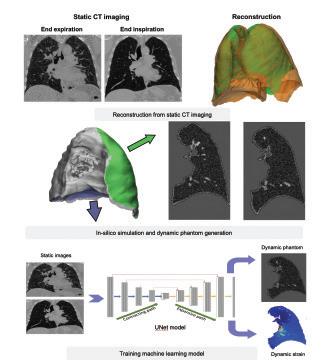
breast imaging system across the entire so-called target population, as was done in the clinical trial referred to above and its in silico representation. Those studies assessed the competing imaging devices for the target population’s distribution of patient ages, sizes, breast densities, lesion types, and so on. Task-based optimization over a broad intended-use population results in a system that is best in an average sense. Notably, that may not be the best imaging system for a subpopulation of subjects (e.g., only women with dense breasts) and especially for one particular patient. A digital twin for a patient is that person’s realistic virtual representation. Similarly, the digital twin of an imaging system is its in silico representation. The creation of a digital twin for a particular patient, along with the models of the other system elements in Figure 1, allows for the probing of what is best in terms of taskbased image quality for that individual. It would be extremely costly, and even unethical in the case of imaging systems involving ionizing radiation, to perform patient-specifc optimizations of imaging systems and imaging settings, of which there are a great many on a sophisticated multipurpose device like a CT or MRI scanner, by repeated image
acquisitions on actual patients. Digital twins for patients and imaging systems are the key to the personalized application of an imaging device to provide optimal healthcare for a given patient.
Figure 3 depicts a metaverse of medical technology and AI built around the concept of digital twins for patients and medical imaging systems. Virtual scanning on a digital twin determines the best imaging protocol for a particular patient and imaging task, followed by actual imaging using that patient-specifc optimized protocol. Human and model/AI observers will be essential to the task-based evaluations that select the best imaging protocol as well as the interpretation of the actual data that comes from the optimized imaging setup. Patient-specifc optimized radiation treatment plans or other image-guided therapies can be similarly imagined as depicted in the fgure. As our modeling tools and AI capabilities grow, imaging system development, prototyping, evaluation, regulation, translation and refnement can all be metaversed through deep connected networks.
FDA is invested in this futuristic vision and is facilitating its coming through its own research as well encouragements for regulated industry to incorporate these methods while also preparing for related medical device submissions. In addition, FDA has partnered with NSF and NIH to support research funding in digital twin technologies for biomedical applications.
Texas A&M has also embraced the power and potential of digital twins and virtual engineering. TAMU’s Institute of Data Science recently announced a new initiative to increase research collaborations in order to advance engineering research through the use of digital twins. In the TAMU Biomedical Engineering Department, researchers like Reza Avazmohammadi and his students are making use of digital twin methodologies to build cohorts of models for healthy patients as well as those with known cardiovascular
and/or pulmonary pathologies. These models can be used to design better approaches to imaging such patients; they can also be used to develop AI algorithms that facilitate the understanding of the underlying mechanisms of disease and its detection. Figure 4 shows an example of this work, in which a lung phantom is generated through a series of steps starting with a human CT scan of the chest: A) segmentation of the lungs, B) extraction of the airways, and C) creation of a fnal lung geometry for use in in silico simulations.
The language and methodology of “task-based image quality assessment” has become commonplace in medical imaging. Tremendous progress is being made toward realistic in silico task-based assessments using population models for patients as well as digital twins for patients and imaging systems. Future eforts that build on studies like the FDA’s VICTRE project will continue to bring down the cost of in silico task-based assessments and system optimization as simulation models are developed, validated, and shared. Open science in this spirit will reduce the redundancy in small eforts while increasing the likelihood of robustness and generalizability of the evaluations that are performed in this manner. This in turn will lead to improved understanding of disease mechanisms and improved imaging systems – defned by improved inferences derived from the resulting images. A Metaverse of ‘Medical Technology and AI’ (MeTAI) is coming that will leverage these tools for the beneft of patients. Researchers at Texas A&M are signifcantly engaged in this feld, building cross-university collaborations in support of model development and sharing best practices across engineering applications of digital twin technologies.
In Collaboration With:
Reza Avazmohammadi, Assistant Professor, Department of Biomedical Engineering
Tanmay Mukherjee, Graduate Student, Department of Biomedical Engineering
Sunder Neelakantan, Hagler Institute for Advanced Study HEEP Fellow, Department of Biomedical Engineering
Bibliography
Barrett, H.H. and Myers, K.J., Foundations of Image Science, Wiley and Sons, New York, (2004).
GitHub - DIDSR/breastPhantom: A multi-modality anthropomorphic digital breast phantom,” (accessed 15 October 2024).
Badano, A., Graf, C.G., Badal, A., Sharma, D., Zeng, R., Samuelson, F.W., Glick, S., Myers, K.J., “Evaluation of Digital Breast Tomosynthesis as Replacement of Full-Field Digital Mammography Using an In Silico Imaging Trial,” JAMA Netw Open 1(7):e185474 (2018).
GitHub - DIDSR/VICTRE: Virtual Imaging Clinical Trial for Regulatory Evaluation, (accessed 15 October 2024).
Wang, G., Badal, A., Jia, X., Maltz, J.S., Mueller, K., Myers, K.J., Niu, C., Vannier, M., Yan, P., Yu, Z., Zeng, R., “Development of Metaverse for Intelligent Healthcare,” Nat. Mach. Intell. 4, 922-929 (2022).
S. Neelakantan, T. Mukherjee, B.J. Smith, K.J. Myers, R. Rizi, R. Avazmohammadi, “In-silico CT lung phantom generated from fnite-element mesh,” Proc. SPIE 12928, Medical Imaging 2024: Image-Guided Procedures, Robotic Interventions, and Modeling, 1292829 (29 March 2024); https://doi.org/10.1117/12.3006973.
A A LER ELLO
RO T E CLASS O
202 24 LE ERS
S EST NO N OR
T E E ELOP ENT
O ANAL T CAL AN
RE ULATOR SC ENCE

ET O S OR ASSESS N T E SA ET
AN E ECT ENESS O E CAL A N
E CES ER OR ESTA L S E
NE T ENERAT ON STU ES NS
AN E ALUAT ON ET O S OR NO EL
E CAL A N AN A NOST CS
PRO UCTS NCLU N TAL
A O RAP REAST A N
LO OSE CT OR LUN CANCER
SCREEN N AN OLE SL E
TAL PAT OLO
AS OUN ER AN PR NC PAL O PUENTE
SOLUT ONS LLC S E NO OR S
AS AN N EPEN ENT RESEARC
COLLA ORATOR AN CONSULTANT
TO E TEC CO PAN ES
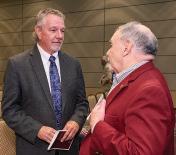
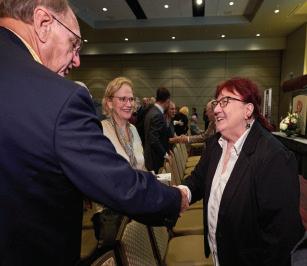

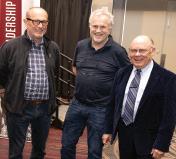
2024-25 HAGLER FELLOW
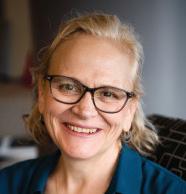
Robert F. Durden Distinguished Professor of Biology and Evolutionary Anthropology Department of Biology
Dean of Natural Sciences
Trinity College of Arts and Sciences
Duke University
Susan C. Alberts is renowned for her pioneering research in the behavior, ecology, physiology and genetics of wild populations of large mammals.
She directs one of the longest-running studies of wild primates globally: a 50-plus year study of baboons in the Amboseli ecosystem in Kenya. This program’s signifcance is underscored by the numerous awards and honors received by its directors, including Alberts, Elizabeth Archie, Jenny Tung and former director Jeanne Altmann.
Alberts received her Ph.D. from the University of Chicago.
She is a member of the National Academy of Sciences and the American Academy of Arts and Sciences as well as a fellow of the American Association for the Advancement of Science.
Honors include the BBVA Frontiers of Science Award, the Distinguished Alumni Award from the Medical and Biological Sciences Alumni Association at the University of Chicago, the Sewall Wright Award from the American Society of Naturalists and the Cozzarelli Prize from the Proceedings of the National Academy of Sciences (PNAS).
She has published more than 150 peer-reviewed articles and serves as a handling editor for PNAS manuscripts.
ALBERTS WILL COLLABORATE WITH FACULTY AND STUDENTS IN THE COLLEGE OF ARTS AND SCIENCES.
2024-25 HAGLER FELLOW
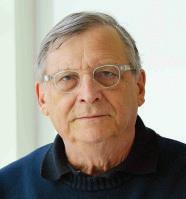
Glenn L. Martin Institute Professor of Engineering Department of Civil and Environmental Engineering A.J. Clark School of Engineering University of Maryland College Park
Renowned for his pioneering work in risk and reliability of civil infrastructure, Gregory B. Baecher has signifcantly advanced the feld of geotechnical and water-resources engineering through the development and implementation of probabilistic methods.
Currently, his scholarship focuses on improving the safety and resilience of civil infrastructure systems by applying these probabilistic approaches.
Baecher received his Ph.D. from Massachusetts Institute of Technology.
He is an emeritus chair of the Department of Civil and Environmental Engineering at the University of Maryland College Park.
Baecher is a member of the National Academy of Engineering and a distinguished member of the American Society of Civil Engineers.
Honors include the Thomas Fitch Rowland Prize from the American Society of Civil Engineers; the Arthur T. Wellington Prize from the American Society of Civil Engineers; the Anwar Wissa Memorial Lecture Award from the American Society of Civil
Engineers Geo-Institute of Florida; the Distinguished Lecture at the University of California, Berkeley, Department of Civil and Environmental Engineering; the Terzaghi Lecture Award from the American Society of Civil Engineers Geo-Institute; the Buchanan Lecture at Texas A&M; the Lacasse Lecture of GEOSnet from the American Society of Civil Engineers; the GEOSnet Distinguished Achievement Award; membership in the University of California, Berkeley, Civil Engineering Academy of Distinguished Alumni; the Panamanian National Award for Science and Technology Innovation; the Commander’s Award for Public Service from the Headquarters of the United States Army Corps of Engineers; the Thomas A. Middlebrooks Award from the American Society of Civil Engineers; the State-of-the-Art Award from the American Society of Civil Engineers; and being a Rockefeller Foundation Post-Doctoral Fellow.
BAECHER WILL COLLABORATE WITH FACULTY AND STUDENTS IN THE COLLEGE OF ENGINEERING.
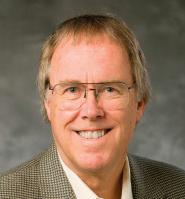
Arts and Sciences Distinguished Professor Emeritus of Statistics Department of Statistical Science College of Arts and Sciences Duke University
James O. Berger is known for his pioneering work in Bayesian statistical analysis, decision analysis and uncertainty quantifcation, as well as the application of statistics to other disciplines such as astronomy, pharmaceutical research and geoscience.
His current research focuses are on the foundations of Bayesian statistics and uncertainty quantifcation for computer modeling of processes (such as climate modeling). He is completing a book on Bayesian model uncertainty, having just fnished an accompanying book on objective Bayesian inference.
Berger received his Ph.D. from Cornell University.
He was the Richard M. Brumfeld Distinguished Professor of Statistics at Purdue University until 1997. He has served as honorary professor at East China Normal University since 2011.
Berger is a member of the National Academy of Sciences and the Spanish Real Academia de Ciencias.
Honors include the Guggenheim Fellowship, the Sloan Fellowship, the Samuel S. Wilks Memorial Award from the American Statistical Association (ASA) and the Arnold Zellner Medal from the International Society of Bayesian Analysis. He received the Wald Lectureship from the Institute of Mathematical Statistics and the Fisher Lectureship from the ASA, the highest honors of each society.
He has authored or co-authored 18 books and 209 peer-reviewed articles.
Berger has served as co-editor of the Annals of Statistics and was a founding co-editor of the Journal on Uncertainty Quantifcation.
BERGER WILL COLLABORATE WITH FACULTY AND STUDENTS IN THE COLLEGE OF ARTS AND SCIENCES.
2024-25 HAGLER FELLOW
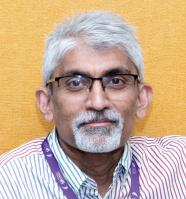
Joseph T. and Bernice S. Lewis Distinguished Service Professor of Marketing Booth School of Business University of Chicago
Pradeep K. Chintagunta is a distinguished scholar in the feld of quantitative marketing, known for his innovative work linking marketing with industrial organization and development economics. His research focuses on development marketing, using marketing and business tools to assist individuals, entrepreneurs and small businesses in emerging economies.
His most notable accomplishment is broadening the feld of quantitative marketing by integrating it with adjacent felds, signifcantly infuencing the development and implementation of marketing strategy.
Chintagunta earned his Ph.D. from Northwestern University.
He is a fellow of the Institute for Operations Research and the Management Sciences (INFORMS)
and the Society for Marketing Science and received the Gilbert A. Churchill, Jr. Award for Lifetime Achievement from the Marketing Research Special Interest Group of the American Marketing Association (AMA).
He ranked as the most productive marketing scholar in premier marketing journals for 2014-23, according to the AMA DocSIG Research Productivity Report. Chintagunta has authored more than 100 peerreviewed articles in marketing, statistics and economics journals.
CHINTAGUNTA WILL COLLABORATE WITH FACULTY AND STUDENTS IN THE MAYS BUSINESS SCHOOL.
2024-25 HAGLER FELLOW

Professor and Chair
Department of Anatomy and Neuroscience University College Cork, Ireland
John F. Cryan is an internationally recognized neuroscientist known for his groundbreaking research on the microbiota-gut-brain axis. His work has signifcantly advanced understanding of how the gut microbiome infuences brain function and behavior, particularly in relation to stress, anxiety and depression.
Cryan’s research employs a multidisciplinary approach, combining neuroscience, microbiology, psychiatry and pharmacology to explore the complex interactions between the brain and gut microbiota.
He received his Ph.D. from the University of Galway, Ireland.
Cryan is a member of the Royal Irish Academy and is a former president of the European Behavioural Pharmacology Society. He was chair of the European College of Neuropsychopharmacology Scientifc Programme Committee from 2022-24.
Honors include the Datta Medal from the Federation of American Societies for Experimental Biology plus awards from Neuroscience Ireland,
American Gastrointestinal Association, American Physiological Society, Neonatal Society, Neurobehavioral Teratology Society, European College of Neuropsychopharmacology, British Association of Psychopharmacology, Royal Academy of Medicine in Ireland as well as from Utrecht University and University College Cork. He received an honorary degree from University of Antwerp.
He has served on the editorial boards of several leading journals in neuroscience and psychopharmacology and is actively involved in numerous international research collaborations.
Cryan has authored more than 600 peer-reviewed publications and fve books, including The Psychobiotic Revolution: Mood, Food, and the New Science of the Gut-Brain Connection.
He is recognized as a Clarivate Analytics Highly Cited Researcher.
CRYAN WILL COLLABORATE WITH FACULTY AND STUDENTS IN THE COLLEGE OF MEDICINE.
2024-25 HAGLER FELLOW
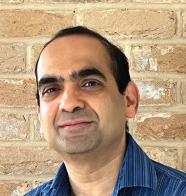
Professor of Materials Engineering Department
of Engineering
Cambridge University, England
A leading scholar in the micromechanics of materials, with a focus on the design of micro-architectured materials and the modeling of soft and active materials, Vikram Deshpande has fundamentally reshaped the feld of microstructural mechanics in both engineering and biological systems. He has created a new area of study that combines experimental innovation with theoretical insights.
He is highly regarded for his contributions to the mechanics of materials, which were highlighted in his citation for election to the Royal Society.
Deshpande earned his Ph.D. from Cambridge University.
He is an international member of the National Academy of Engineering,
a fellow of the Royal Academy of Engineering and a fellow of the Royal Society of London.
Honors include the Zdeněk P. Bažant Medal for Failure and Damage Prevention from the American Society of Civil Engineers, the Warner T. Koiter Medal from the American Society of Mechanical Engineers and the Rodney Hill Prize in Solid Mechanics.
He has authored more than 350 peer-reviewed articles and four book chapters. He holds four patents.
DESHPANDE WILL COLLABORATE WITH FACULTY AND STUDENTS IN THE COLLEGE OF ENGINEERING.
2024-25 HAGLER FELLOW

Distinguished Professor of Astronomy
Department of Astronomy, College of Letters and Science University of California, Berkeley
Alexei V. Filippenko is renowned for his research on supernovae, black holes, active galaxies, gamma-ray bursts, neutron stars, dark matter and observational cosmology.
He was a pivotal member of the teams that discovered the accelerating expansion of the universe in 1998, a groundbreaking achievement that contributed to the awarding of the Nobel Prize in Physics to the teams’ leaders for discovering gravitationally repulsive dark energy. Filippenko earned his Ph.D. from the California Institute of Technology.
He holds a Richard and Rhoda Goldman Distinguished Professorship in the Physical Sciences at the University of California, Berkeley, where he has made signifcant contributions to the feld of astrophysics.
He is a member of the National Academy of Sciences and the American Academy of Arts and Sciences. Honors include the Carnegie Foundation for the Advancement of Teaching/Council for Advancement and Support of Education National Professor of the Year, the Gruber Cosmology Prize and the Breakthrough Prize in Fundamental Physics.
He has authored nearly 1,000 peer-reviewed articles and has contributed extensively to conference proceedings and book chapters.
FILIPPENKO WILL COLLABORATE WITH FACULTY AND STUDENTS IN THE COLLEGE OF ARTS AND SCIENCES.
2024-25 HAGLER FELLOW

Professor
Holder of the Grainger Distinguished Chair in Engineering Department of Civil and Environmental Engineering Grainger College of Engineering University of Illinois Urbana-Champaign
Youssef M.A. Hashash is a leading expert in geotechnical earthquake and tunnel engineering, known for his innovative work in numerical modeling, seismic analysis of underground structures, and static and seismic soil-structure interaction.
His expertise extends to the application of artifcial intelligence and deep learning in geotechnical engineering, signifcantly advancing the design and safety of infrastructure.
His research has led to the development of state-of-the-art computational tools, including the widely used DEEPSOIL software for non-linear seismic site response analysis.
Hashash earned his Ph.D. in civil engineering from the Massachusetts Institute of Technology.
He has served as president of the Geo-Institute of the American Society of Civil Engineers (ASCE).
Hashash is a member of the National Academy of Engineering.
Honors include the Peck Medal and the Huber Prize from ASCE and the Presidential Early Career Award for Scientists and Engineers.
He has authored more than 130 peer-reviewed publications and holds fve patents.
HASHASH WILL COLLABORATE WITH FACULTY AND STUDENTS IN THE COLLEGE OF ENGINEERING AND THE COLLEGE OF ARCHITECTURE.
2024-25 HAGLER FELLOW
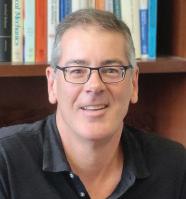
C. Judson King Distinguished Professor University of California, Berkeley
Known for his pioneering research in developing innovative materials for clean energy and sustainability, Jefrey R. Long has made a signifcant impact on the felds of chemistry and materials science.
His current research focuses on the discovery of chemically-selective cooperative adsorption in metal–organic frameworks and its uses in the efcient separation of carbon dioxide from fue gases and air.
Long’s work extends to the development of hydrogen storage materials and advanced porous materials for gas separation and catalysis, which are crucial for sustainable energy solutions.
He received his Ph.D. from Harvard University in 1995.
Long is a member of the National Academy of Sciences and the American Academy of Arts and Sciences.
Honors include the Eni Award Energy Transition Prize; the Department of Energy Achievement Award for Driving U.S. Competitiveness and Innovations Team; the Miller Research Professorship
at UC Berkeley; the Royal Society of Chemistry Ludwig Mond Award; the Department of Energy Frontier Research Centers Ten at Ten Award; the American Chemical Society F. Albert Cotton Award in Synthetic Inorganic Chemistry; the Department of Energy Hydrogen and Fuel Cells Program R&D Award for Hydrogen Storage; the Bakar Fellowship at UC Berkeley; the Inorganic Chemistry Lectureship Award; the National Fresenius Award; the National Science Foundation Special Creativity Award; the TR100 Award; the Wilson Prize at Harvard University; the Alfred P. Sloan Research Fellowship; the Camille Dreyfus Teacher-Scholar Award; the Hellman Family Faculty Award; and the Research Corporation Research Innovation Award.
He has authored two book chapters and 402 peer-reviewed articles. Long holds 23 patents.
LONG WILL COLLABORATE WITH FACULTY AND STUDENTS IN THE COLLEGE OF ARTS AND SCIENCES.
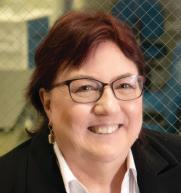
Founder, CEO, and Chief Science Ofcer, INCELL Corporation LLC INCELL Director of Clinical Therapies, Product Development, and Research Adjunct Professor, University of Texas Health Science at San Antonio
Mary Pat Moyer is a distinguished biomedical scientist, entrepreneur and manager with more than fve decades of experience in biomanufacturing clinical and research-use products for regenerative medicine and infectious diseases.
At INCELL Corporation, she leads the development of innovative products, focusing on human cells, tissues, cell culture, human cellular and tissue-based products, and FDA-registered facilities.
Moyer’s notable accomplishments include leading two INCELL-sponsored Investigational New Drug applications for cell therapies to treat amyotrophic lateral sclerosis, showcasing the frst-ever successful treatment that improved disease symptoms.
Her expertise spans human cell therapies, infectious diseases, microbiology, virology and cancer disease mechanisms, as well as sponsorship, development, manufacturing, testing, pre-clinical and clinical studies, and commercialization of new products.
She received her Ph.D. from The University of Texas at Austin.
Moyer is a member of the National Academy of Engineering and a fellow of the American Academy of Microbiology.
Honors include the Ernst and Young Entrepreneur of the Year, the Breaking the Glass Ceiling Award from the American Association of University Women and the Athena International Award for Women in Leadership.
She has authored 15 books or book chapters, more than 220 peerreviewed articles and 12 Drug and Device Master Files for the Food and Drug Administration, which provide confdential detailed information about the facilities, processes or articles used in the manufacturing of drugs and medical devices; she also holds three patents.
MOYER WILL COLLABORATE WITH FACULTY AND STUDENTS IN THE COLLEGE OF MEDICINE.
2024-25 HAGLER FELLOW
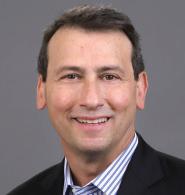
David Lee/Ernst Weber Professor of Electrical Engineering Department of Electrical and Computer Engineering Tandon School of Engineering
New York University
Known for his pioneering work in wireless communications, Theodore S. Rappaport is considered the “father of 5G millimeter wave.” Rappaport demonstrated the viability of millimeterwave frequency bands for wi-f and cellular applications, revolutionizing the telecommunications industry.
His research encompasses wireless communications theory, radio propagation, antennas, channel modeling, radio circuit design and millimeter-wave and terahertz communications. Rappaport also developed a global standard for modeling millimeter-wave wireless communication channels and the waste factor theory to quantify energy efciency in communication networks.
Rappaport earned his Ph.D. from Purdue University.
He is the founding director of NYU WIRELESS, a multidisciplinary academic research center at New York University.
Rappaport is a member of the National Academy of Engineering and the Wireless History Foundation Wireless Hall of Fame, and a fellow of the National
Academy of Inventors, the Institute of Electrical and Electronics Engineers (IEEE) and the Radio Club of America.
Honors include the IEEE Eric E. Sumner Field Award; the American Society for Engineering Education Frederick E. Terman Award; induction into the IEEE Vehicular Technology Society Hall of Fame; the Institution of Engineering and Technology Sir Monty Finniston Award for Achievement in Engineering and Technology; the University of Texas Joe J. King Professional Engineering Achievement Award; the Virginia Tech Distinguished Alumni Award; recognition as a National Science Foundation Presidential Faculty Fellow; and the Marconi Society Young Scientist Award.
He has authored 24 books, including four textbooks, and has more than 100 U.S. and international patent applications issued or pending.
RAPPAPORT WILL COLLABORATE WITH FACULTY AND STUDENTS IN THE COLLEGE OF ENGINEERING.
2024-25 HAGLER
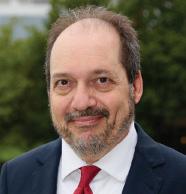
Professor
Holder of the Gary C. Butler Family Chair School of Industrial and Systems Engineering Chemical and Biomolecular Engineering Georgia Institute of Technology
Nick Sahinidis is a renowned scholar in the felds of mathematical optimization and machine learning. His work has infuenced both academic research and practical applications, particularly through the development of widely used algorithms and software for optimization and machine learning.
Sahinidis earned his Ph.D. from Carnegie Mellon University.
He is a member of the National Academy of Engineering and a fellow of the American Institute of Chemical Engineers (AIChE), the Institute for Operations Research and the Management Sciences (INFORMS) and the Asia-Pacifc Artifcial Intelligence Association.
Honors include the INFORMS Computing Society Prize, the BealeOrchard-Hays Prize, the Computing in Chemical Engineering Award, the Constantin Carathéodory
Prize and the National Award and Gold Medal from the Hellenic Operational Research Society.
He serves as an editor for Optimization and Engineering, the AIChE Journal, Computational Management Science, Computational Optimization and Applications, the Journal of Global Optimization, Mathematical Programming Computation, Operational Research—An International Journal, Operations Research Forum and Optimization Letters.
Sahinidis has authored 18 books or book chapters and more than 150 peer-reviewed articles. He also holds one patent.
SAHINIDIS WILL COLLABORATE WITH FACULTY AND STUDENTS IN THE ENERGY INSTITUTE.
2024-25 HAGLER FELLOW
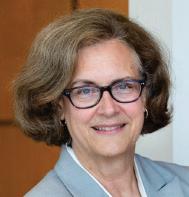
Andrea Mitchell University Professor of Law, Political Science and Business Ethics Penn Law School, School of Arts and Sciences and Wharton Business School University of Pennsylvania
Beth A. Simmons is known for her research on international relations, human rights, and international law. Her work has infuenced the understanding and implementation of international law, particularly in human rights and global governance. Her current research focuses on international borders, border governance, human rights and the difusion of norms in global politics.
Simmons received her Ph.D. from Harvard University.
At the University of Pennsylvania, she teaches courses on international law, international relations and ethics.
She is a member of the National Academy of Sciences, the American Academy of Arts and Sciences and the American Philosophical Society. Honors include the Woodrow Wilson Award and the Stein Rokkan Prize for her book, “Mobilizing for Human Rights: International Law in Domestic Politics.”
Simmons was elected president of the International Studies Association and directed the Weatherhead Center for International Afairs as a professor at Harvard. She delivered the Lauterpacht Lecture in International Law at Cambridge University in 2024.
She has served on the editorial boards of more than a dozen disciplinary and interdisciplinary journals, including the American Political Science Review and the American Journal of International Law.
SIMMONS WILL COLLABORATE WITH FACULTY AND STUDENTS IN THE BUSH SCHOOL OF GOVERNMENT AND PUBLIC SERVICE.
2024-25 HAGLER FELLOW

Distinguished Professor
Holder of the Edward Carter Chair in Business Administration Anderson School of Management University of California, Los Angeles
Christopher Tang is renowned for his pioneering work in global supply chain management, focusing on resilient supply chain management and supply chain risk management. His research has infuenced the felds of operations and business management, emphasizing the importance of developing robust and adaptable supply chains in an increasingly globalized economy.
Tang received his Ph.D. from Yale University.
At UCLA, he serves as the senior associate dean of global initiatives and the director of the Center for Global Management at the Anderson School of Management.
Tang is a fellow of the Institute for Operations Research and the Management Sciences (INFORMS), the Manufacturing and Service Operations Society, and the Production and Operations Management Society (POMS). He is also an inaugural fellow of the Responsible Research in Business and Management Network.
Tang has been recognized as one of the world’s most infuential re-
searchers, ranking in the top 1% based on Web of Science citations.
He has authored or co-edited eight books, more than 30 book chapters and more than 200 peer-reviewed articles. His work on resilient supply chain management is widely cited and has received best paper awards from INFORMS and POMS. He wrote one of the top 10 Google Scholar Classic Papers in operations research for 2017.
He is the editor-in-chief of Manufacturing and Service Operations Management; a department editor for Management Science, Production and Operations Management, Service Science, and IISE Transactions; and an associate editor for Operations Research, Manufacturing and Service Operations Management and the Journal of Operations Management.
TANG WILL COLLABORATE WITH FACULTY AND STUDENTS IN THE MAYS BUSINESS SCHOOL.
2024-25 HAGLER DISTINGUISHED LECTURER
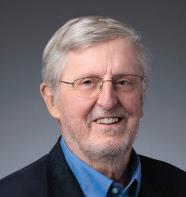
Professor Emeritus
Holder of the Jack and Laura Dangermond Chair Department of Geography College of Letters and Science University of California, Santa Barbara
Michael F. Goodchild is globally acknowledged as the “Father of Geographic Information Science (GIScience),” widely credited with coining the term “Volunteered Geographic Information (VGI)” and is considered the foremost expert on the topic.
His work has been instrumental in fostering interdisciplinary collaboration between GIScience, urban science, computer science, and other felds, laying the foundation for the advancement of spatial databases, data modeling and the integration of spatial data with other information systems.
Goodchild’s contributions have positioned GIScience as a hub for innovative approaches to spatial data analysis, geodesign and the development of digital twins.
He earned his Ph.D. from McMaster University.
He is a member of the National Academy of Sciences and the American Academy of Arts and Sciences, and a fellow of the Royal Society and the British Academy.
Honors include the Prix Vautrin Lud, the highest award in the feld of geography, and the Founder’s Medal from the Royal Geographical Society. He has also received fve honorary degrees.
With 598 peer-reviewed articles and 15 books or book chapters, Goodchild’s written works are highly regarded for their relevance to contemporary GIScience discourse and their insightful recommendations for future directions in the feld.
GOODCHILD WILL COLLABORATE WITH FACULTY AND STUDENTS IN THE COLLEGE OF ARCHITECTURE .
Philip Calder
Head, School of Human Development and Health
Professor, Nutritional Immunology
University of Southampton, United Kingdom Research: Infuence of diet and nutrients on immune and infammatory responses and on metabolism and functionality of the roles of omega-3 fatty acids
Alicia L. Carriquiry
Distinguished Professor and holder of the President’s Chair in Statistics Director, Center for Statistics and Applications in Forensic Evidence Department of Statistics
Iowa State University Research: Bayesian statistics and applications of statistical methodology
George Georgiou
Professor, Cockrell School of Engineering
Dula D. Cockrell Centennial Chair in Engineering #2
The University of Texas at Austin Research: Adaptive-immune response and improving enzyme and antibody therapeutics for cancer treatment and inborn errors of metabolism
Jody Gookin
FluoroScience Distinguished Professor of Veterinary Scholars Research Education College of Veterinary Medicine
North Carolina State University Research: Tritrichomonas foetus in cats and gallbladder mucocele disease in dogs
Mae Jemison
President
The Jemison Group, Inc.
Research: Integrating the physical and social sciences with art and culture to solve problems and foster innovation
Eric S. Maskin
Adams University Professor Professor, Economics and Mathematics
Harvard University Research: Game theory, contract theory, social-choice theory and political economy
H. Richard Milner IV Professor of Education
Cornelius Vanderbilt Chair of Education
Immediate Past Joseph A. Johnson, Jr. Distinguished Leadership Professor Department of Teaching and Learning Professor of Sociology (Secondary) Professor of Education Policy Studies (Secondary)
Founding Director, Initiative for Race Research and Justice
Peabody College of Education and Human Development, Vanderbilt University Research: Capturing students’ experiences in schools, race and culture in education science
Kyle J. Myers
Principal, Puente Solutions LLC
Research: Development of analytical and regulatory science methods for the accuracy and safety of medical imaging devices
Konstantin Novoselov
Director, Institute for Functional Intelligent Materials
Tan Chin Tuan Centennial Professor
National University of Singapore
Research: Condensed matter physics, mesoscopic physics and nanotechnology
Eleftherios T. Papoutsakis
Unidel Eugene DuPont Chaired Professor, Chemical and Biomolecular Engineering
Professor, Biological Sciences
University of Delaware
Research: Molecular biotechnology and synthetic biology for sustainable manufacturing and the development of human therapeutics
Radia Perlman
Fellow, Dell EMC
Research: Development and advancement of modern computer networks
Soroosh Sorooshian
Director, Center for Hydrometeorology and Remote Sensing
Distinguished Professor and the Henry Samueli Chair
Departments of Civil and Environmental Engineering and Earth System Science
University of California, Irvine
Research: Remote sensing and development of improved precipitation runof modeling
Robyn Tanguay
University Distinguished Professor, Environmental and Molecular Toxicology
Director of the Superfund Research Program, the Sinnhuber Aquatic Research Laboratory
Former Director of the Environmental Health Sciences Center
Oregon State University
Research: Zebrafsh as toxicology models
Günter Wagner
Research Lab Director, Systems Biology Institute
Alison Richard Professor Emeritus, Ecology and Evolutionary Biology
Yale University
Senior Research Fellow, University of Vienna, Austria
Research: Evolution of genes and gene networks
Guy Bertrand
Distinguished Professor of Chemistry and Biochemistry
Director, UCSD-CNRS Joint Research Chemistry Laboratory
University of California San Diego
Research: Taming reactive molecules and transforming them into useful tools for synthetic chemists
Hui Cao
John C. Malone Professor of Applied Physics
Professor of Physics and professor of Electrical Engineering
Department of Applied Physics
Yale University
Research: Understanding and controlling light transport, scattering, absorption and amplifcation in complex photonic nanostructures
John Michael Cullen
Distinguished Professor, Associate in the Toxicology Faculty and Adjunct Senior Researcher, Hammer Institute
Department of Population Health and Pathobiology
College of Veterinary Medicine
North Carolina State University
Research: Drug-induced hepatic disease and animal models of viral hepatitis
Odile Eisenstein
Director de Recherche CNRS Emeritus, Institut Charles Gerhardt Montpellier
CTMM group Universite de Montpellier
Hylleraas Center for Quantum Molecular Science
University of Oslo, Norway
Research: Molecular organic and organometallic chemistry
Dimitar Filev
Henry Ford Technical Fellow
Ford Research and Innovation Center
Research: Computational intelligence, artifcial intelligence and intelligent control
Howard Frumkin
Senior Vice President, the Trust for Public Land
Professor Emeritus of Environmental and Occupational Sciences
School of Public Health
University of Washington
Research: Public health aspects of the built environment
Sebastian (Bas) Jonkman
Professor and holder of the Integral Hydraulic Engineering Chair
Delft University of Technology, Netherlands Research: Flood risk management, land reclamation and the integral design of hydraulic infrastructure
Mark O’Malley
Leverhulme Professor of Power Systems
Imperial College London Research: Integrating wind-energy systems into smart grids
Lawrence Que Jr.
Regents Professor
College of Science and Engineering
University of Minnesota
Research: Understanding how non-heme iron centers activate oxygen to carry out a diverse array of metabolically important reactions
Jean-Paul Rodrigue
Professor
Department of Global Studies and Geography
Hofstra University
Research: Mobility, freight distribution, containerization, logistics and transport terminals
Donald L. Sparks
Francis Alison Professor and holder of the Unidel S. Hallock du Pont Chair in Soil and Environmental Chemistry Professor, Chemistry and Biochemistry Director, Delaware Environmental Institute College of Agriculture and Natural Resources University of Delaware
Research: Kinetics of geochemical processes, molecular scale investigations of metal and nutrient fate, transport in soils and water, soil remediation and climate change impacts on soil
Madhavi Sunder
Frank Sherry Professor of Intellectual Property and Associate Dean for International and Graduate Programs
Georgetown Law Center
Research: Intellectual property law and extending into culture, human rights and the First Amendment
Michael W. Young
Nobel Prize in Physiology or Medicine
Richard and Jeanne Fisher Professor Head, Laboratory of Genetics Vice President for Academic Afairs
The Rockefeller University Research: Biological clocks that regulate the human body’s sleep patterns, metabolism and response to disease
David Zilberman
Distinguished Professor and holder of the Robinson Chair
Department of Agricultural and Resource Economics College of Natural Resources University of California, Berkeley Research: Agricultural and environmental policy; economics of innovation and risk; water biotechnology; and climate change
Arthur M. Jafe
Landon T. Clay Professor of Mathematics and Theoretical Sciences
Department of Physics
Harvard University
Research: The relation between super symmetry and a new mathematical subject — non-commutative geometry — where one builds quantum space into the notion of space-time
Kevin G. Bowcutt
Principal Senior Technical Fellow and Chief Scientist of Hypersonics Boeing Research and Technology Research: Hypersonic aerodynamics, propulsion integration and vehicle design and optimization
Jacqueline H. Chen
Senior Scientist
Combustion Research Facility
Sandia National Laboratories
Research: Applies massively parallel computing to the simulation of turbulent combustion
Jennifer H. Elisseef
Jules Stein Professor
Department of Biomedical Engineering
Morton Goldberg Professor, Ophthalmology Director, Translational Tissue Engineering Center
Johns Hopkins University
Research: Regenerative medicine, biomaterials, tissue engineering, immunoengineering and biomedical engineering
Theodore Goodson III
Richard Barry Bernstein Collegiate Professor of Chemistry and Macromolecular Science and Engineering
Department of Chemistry
University of Michigan
Research: Non-linear optical properties of novel organic materials
Nancy R. Sottos
Department Head and holder of the Maybelle Leland Swanlund Endowed Chair Center for Advanced Study Professor
Materials Science and Engineering
The Grainger College of Engineering
University of Illinois Urbana-Champaign Research: Self-healing materials for energy and the environment, mechanical properties and materials for extreme conditions
Donna T. Strickland
Professor
Department of Physics and Astronomy
University of Waterloo Ontario, Canada
Research: Develops novel ultrafast laser systems to study nonlinear optical phenomena
Nikolay I. Zheludev
Professor and Deputy Director of the Zepler Institute
University of Southampton, United Kingdom Co-Director, The Photonics Institute
Nanyang Technological University, Singapore Research: Nanophotonics, metamaterials, nanotechnology, electrodynamics and nonlinear optics
R. Graham Cooks
Henry B. Hass Distinguished Professor of Analytical Chemistry
Department of Chemistry
College of Science
Purdue University
Research: Mass spectrometry, including fundamental phenomena, instrumentation and analytical applications
Andrew P. Feinberg
Director, Center for Epigenetics
Johns Hopkins University School of Medicine
Bloomberg Distinguished Professor
Whiting School of Engineering and Bloomberg School of Public Health
Johns Hopkins University
Research: Multidisciplinary research spans many felds, from genetics to computational biology and mathematics
James J. Giovannoni
Director
Robert W. Holley Center for Agriculture and Health Laboratory
USDA-ARS
Adjunct Professor
Boyce Thompson Institute
Cornell University
Research: Molecular and genetic analysis of fruit physiology and ripening and signal transduction systems in the tomato and additional fruit species
Paula T. Hammond
David H. Koch (1962) Professor in Engineering
Head, Department of Chemical Engineering
School of Engineering
Massachusetts Institute of Technology (MIT)
Research: Macromolecular design and synthesis, targeted drug delivery for cancer, nanoscale assembly of synthetic biomaterials and electrostatic and directed materials assembly
Timothy A. Judge
Joseph A. Alutto Chair in Leadership Efectiveness
Department of Management and Human Resources
Fischer College of Business
The Ohio State University
Research: Clarifes the role of personality in job performance, job attitudes and career success
Julia King
Professor Baroness Brown of Cambridge, Crossbench Life Peer, House of Lords, London
Chair, Sir Henry Royce Institute for Advanced Materials, Carbon Trust Research: Science, technology and policy to support low-carbon and new negative-emissions science
Gloria Ladson-Billings
Former Kellner Family Distinguished Professor
Department of Educational Policy Studies
School of Education
University of Wisconsin-Madison
Research: Examines the pedagogical practices of teachers who are successful with African American students and investigates applications of critical race theory to education
Rachel F. Moran
Distinguished Professor School of Law
University of California, Irvine
Research: Education policy, civil right and race and the law
Shaul Mukamel
Distinguished Professor
Department of Chemistry School of Physical Sciences
University of California, Irvine
Research: Studies molecules by measuring their response to short pulses of light. Pioneered the feld of coherent ultrafast multidimensional molecular spectroscopy
Lena Cowen Orlin
Professor
Department of English
Georgetown University
Research: Expert on private domestic life during the Renaissance and specializes in works of Shakespeare
Luiz Davidovich
Professor of Physics
Instituto de Física
Universidade Federal do Rio de Janeiro
Research: Decoherence, dynamics of entanglement, laser theory and quantum metrology
Sharon Donovan
Professor and holder of the Melissa M. Noel Endowed Chair in Nutrition and Health Department of Nutritional Sciences College of Agricultural, Consumer and Environmental Sciences University of Illinois at Urbana-Champaign
Research: Pediatric nutrition, focusing on optimizing intestinal and cognitive development and on development of the gut microbiome
Mario Andrés Hamuy
Vice President and Head of Mission, Chile Association of Universities for Research in Astronomy
Washington, DC
Research: Established the use of supernovas to measure distances into the far universe, leading to the discovery of the accelerated expansion of the universe
Peter J. Hotez
Dean, National School of Tropical Medicine
Professor
Departments of Pediatrics and Molecular Virology and Microbiology
Endowed Chair in Tropical Pediatrics
Baylor College of Medicine
Research: Neglected tropical diseases and vaccine development
Kathleen C. Howell
Hsu Lo Distinguished Professor
School of Aeronautics and Astronautics
College of Engineering
Purdue University
Research:Contributions to the three body problem, the interplanetary superhighway and artifcial satellite theories
Misha Lyubich
Professor
Department of Mathematics
Director, Institute for Mathematical Sciences College of Arts and Sciences
Stony Brook University
Research: Analytic low-dimensional dynamics of recursive maps
Henry Rousso
Directeur de recherche de Classe Exceptionelle
French National Centre for Scientifc Research
Paris, France
Research: Link between history and memory and historical trauma
Peter W. Shor
Henry Adams Morss and Henry Adams Morss Jr. Professor of Applied Mathematics School of Science
Massachusetts Institute of Technology
Research: Quantum algorithm for factoring exponentially faster than the best currently known algorithm running on a classical computer
Edwin L. “Ned” Thomas
Ernest Dell Butcher Professor of Engineering
Department of Materials Science and Nanoengineering School of Engineering
Rice University
Research: Development of novel photonic materials and determination of the morphology of black copolymers
Vanderlei Salvador Bagnato
Professor
Department of Physics and Materials Science University of São Paulo and the Institute of Physics of São Carlos
Brazil
Research: Laser cooling, trapping neutral atoms and applying the principles of optics and lasers in health sciences
Michael J. Duf
Emeritus Professor of Theoretical Physics
Senior Research Investigator
Imperial College
London
Research: Quantum gravity, quantum informatics, string theory, M-theory and unifed theories of the elementary particles
Yonggang Huang
Walter P. Murphy Professor of Mechanical Engineering, Civil and Environmental Engineering, and Materials Science and Engineering
McCormick School of Engineering and Applied Science
Northwestern University
Research: Mechanics of stretchable materials and additive manufacturing
Cameron Jones
Professor and holder of the R.L. Martin Distinguished Chair of Chemistry
Monash University
Melbourne, Australia
Research: Existing views on structure, bonding and stability
Stefan H.E. Kaufmann
Head, Department of Immunology
Founding Director
Max Planck Institute for Infection Biology
Germany
Research: Vaccines for tuberculosis
H. Vincent Poor
Michael Henry Strater University Professor Department of Electrical and Computer
Engineering
School of Engineering and Applied Science
Princeton University
Research: Advancing rapid development of technology
Robert D. Putnam
Peter and Isabel Malkin Research Professor of Public Policy
Kennedy School of Government
Harvard University
Research: Religion in society, the fall and revival of American community and opportunity gaps
Andrea Rinaldo
Professor of Hydrology and Water Resources Director, Laboratory of Ecohydrology École Polytechnique Fédérale de Lausanne
Switzerland
Research: Theory of self-organized fractal river networks and efcient transportation networks
William G. Unruh
Professor of Physics
Department of Physics and Astronomy
University of British Columbia
Research: General relativity and refning the foundations of quantum mechanics in relation to black holes
Vijay K. Dhir
Distinguished Professor Departments of Mechanical and Aerospace Engineering and Chemical and Biomolecular Engineering
Samueli School of Engineering University of California, Los Angeles Research: Fundamental and applied sciences involving boiling
Richard A. Dixon
Distinguished Research Professor Department of Biological Sciences College of Science University of North Texas Research: Metabolic engineering of plants
Richard A. Epstein
Laurence A. Tisch Professor of Law Director, Classical Liberal Institute School of Law
New York University
Research: Legal theory property, torts, and employment
Tom Ginsburg
Leo Spitz Professor of International Law Ludwig and Hilde Wolf Research Scholar Professor of Political Science
University of Chicago Law School Research: Multidisciplinary social scientifc analysis to comparative constitutional law
James E. Hubbard Jr.
Glenn L. Martin Institute Professor
Samuel P. Langley Distinguished Professor Department of Aerospace Engineering University of Maryland Research: Designs, develops and defnes the state of the art in robotic platforms
Thomas J. Stipanowich
William H. Webster Chair in Dispute Resolution Professor of Law Straus Institute for Dispute Resolution Caruso School of Law Pepperdine University Research: Commercial arbitration and dispute resolution
Jerry Tessendorf Professor of Visual Computing School of Computing College of Engineering, Computing and Applied Sciences
Clemson University Research: Fluid simulations in computer graphics for motion pictures
Christopher C. Cummins
Henry Dreyfus Professor of Chemistry
Department of Chemistry School of Science
Massachusetts Institute of Technology Research: Synthetic chemistry and inorganic synthesis methodology
Ingrid Daubechies
James B. Duke Distinguished Professor Departments of Mathematics and Electrical and Computer Engineering
Pratt School of Engineering, Trinity College of Arts and Sciences
Duke University
Research: Wavelet and mathematical methods
Gerald Galloway
Professor Emeritus
Department of Civil and Environmental Engineering
A. James Clark School of Engineering
University of Maryland
Research: Civil engineering and food plain management
Huajian Gao
Walter H. Annenberg Professor of Engineering
School of Mechanical and Aerospace Engineering
Brown University
Research: Mechanical and biological engineering
Maryellen Giger
A. N. Pritzker Distinguished Service Professor Department of Radiology
Committee on Medical Physics
The College at the University of Chicago Research: Computer-aided diagnosis, digital signal and image processing
Robert Kennicutt Jr.
Plumian Professor of Astronomy and Experimental Philosophy, Emerita School of Physical Sciences
University of Cambridge Research: Astronomy, star formation and galaxies
Charles E. Kolb
Former President and Chief Executive Ofcer Aerodyne Research Inc.
Research: Atmospheric chemistry, air quality and climate
V. Kumar
Professor of Marketing
Goodman Academic-Industry Partnership Professor
Goodman School of Business
Brock University
Research: Marketing research methods, customer relationship management
William M. Sage
James R. Dougherty Chair for Faculty Excellence
Professor
Department of Surgery and Perioperative Care
Dell Medical School
School of Law
The University of Texas at Austin Research: Law and national health care reform
Thomas S. Ulen
Research Professor
Swanlund Chair Emeritus College of Law
University of Illinois at Urbana-Champaign
Research: Law, economics, legal, scholarship and legal education
W. David Arnett
Regents Professor Emeritus
Department of Astronomy College of Science
University of Arizona
Research:Theoretical astrophysics, supernovae and stellar astronomy
John T. Brosnan
Professor Emeritus
Department of Biochemistry
Memorial University of Newfoundland Research: Amino acid biochemistry
Robert A. Calderbank
Charles S. Sydnor Distinguished Professor
Departments of Electrical and Computer Engineering and Mathematics
Director, Rhodes Information Initiative
Pratt School of Engineering, Trinity College of Arts and Sciences
Duke University
Research: Computer science, electrical engineering and mathematics
Richard Delgado
John J. Sparkman Chair of Law School of Law
The University of Alabama Research: Critical race theory and law
Richard Gibbs
Woford Cain Chair and Professor
Department of Molecular and Human Genetics
Director and Founder, Human Genome Sequencing Center
Baylor College of Medicine
Research: Genome science and human molecular evolution
J. Karl Hedrick
James Marshall Wells Academic Chair and Professor
Department of Mechanical Engineering College of Engineering
University of California, Berkeley
Research: Nonlinear control theory and automotive control systems
Alan Needleman
Professor of Materials Science and Engineering
University of North Texas
Research: Materials science and engineering
Aleda Roth
Burlington Industries Distinguished Professor of Supply Chain Management
Department of Management
Wilburn O. and Ann Powers College of Business
Clemson University
Research: Global supply chain management
Vernon Smith
Nobel Prize in Economics
George L. Argyros Endowed Chair in Finance and Economics, Professor of Economics and Law
Founder, Economic Science Institute
The George L. Argyros School of Business and Economics, Dale E. Fowler School of Law
Chapman University
Research: Experimental economics
Katepalli Sreenivasan
Dean Emeritus of NYU Tandon School of Engineering
Eugene Kleiner Professor for Innovation in Mechanical Engineering University Professor
Departments of Physics and Mathematics
College of Arts and Science, Courant Institute of Mathematical Sciences
New York University
Research: Mechanical engineering


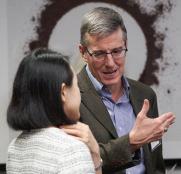
By attracting visionary scholars whose work inspires collaboration and innovation, the Hagler Institute for Advanced Study infuses their extraordinary knowledge, talents and networks into Texas A&M to amplify its academic impact, reinforcing our mission to prepare students and faculty to lead in a rapidly evolving world.

ALAN SAMS
Provost and Executive
Vice President
Texas A&M University
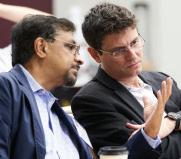
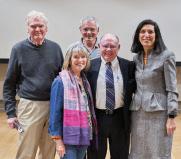
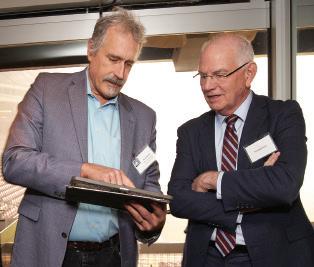
In fscal year 2017, Jon L. Hagler ’58 committed a $10 million cash gift and a $10 million estate gift to help endow what is now the Hagler Institute for Advanced Study.
Jon L. Hagler’s endowment, coupled with Academic Master Plan funds ($1.8 million per year in 2016 dollars) and Heep Foundation earnings ($400,000 per year) contributed by Texas A&M University President, General (Ret.) Mark A. Welsh III, ensure that the Hagler Institute will serve permanently as a beacon of excellence at Texas A&M.
The 2024-25 class of Hagler Fellows reached new heights with a total of 19 fellows plus one distinguished lecturer, fnanced in part with surplus funds from prior years. The institute’s current fnancing is enough to support an average of about 10 new Hagler Fellows per year. Our goal is to increase endowment funding to a level that will fully support 20 fellows annually on an ongoing basis.
Hagler Institute revenues exceeded its expenditures for academic fscal year 2024, which ended Aug. 31, 2024. The largest sources of revenues came from Texas A&M to pay operating expenses and compensation to fellows. Endowment income continues to grow, however, and we hope someday it will become our largest source of revenue.
Compensation to fellows and distinguished lecturers paid by the Hagler Institute during fscal year 2024 totaled $1,068,892 and included compensation for over 30 fellows and lecturers spanning class years 2017-18 to 2024-25. Due to fellows now serving their terms in the institute over a three-to-four-year period, it is common to have fellows from multiple classes on campus at any one time.
Hagler Institute expenditures during fscal year 2024 for operating and miscellaneous expenses and salaries totaled $1,333,742. This expense category is defned broadly and includes staf salaries, student workers, ofce supplies, expenditures for the annual Hagler Institute gala, support for symposiums and Lindau Nobel Laureate meetings, production of our annual report and a brochure with the Texas A&M Foundation, support for Fellows gatherings and a host of other miscellaneous expenditures.
Fiscal year 2024 expenditures for student fellowships totaled $509,164. These fellowship expenditures enable students to work directly on research with Hagler Fellows and their Texas A&M faculty hosts.
The expenditures noted above and shown in the charts on the following page are reported on a cash basis and
Our goal is to increase endowment funding to a level that will fully support 20 fellows annually on an ongoing basis.
do not refect outstanding commitments for future expenditures. For example, the Hagler Institute’s obligations to fellows and distinguished lecturers of the newly recruited 2024-25 class sum to $2,584,400 in potential stipends, while total stipends paid by the institute during fscal year 2024 to fellows and lecturers of all class years totaled $1,068,892.
The fgures shown in the charts exclude revenues and expenditures which are accounted for within specifc colleges but nonetheless related to Hagler Fellows, including but not limited to revenue from endowments which are devoted to the support of Hagler Fellows but housed within the colleges rather than the Hagler Institute. For example, the $2,584,400 obligation noted above with respect to the 2024-25 class pertains to stipends for only 14 of the 19 fellows, along with the distinguished lecturer, because fve of the 19 fellows will be supported from endowments devoted solely to support of Hagler Fellows but placed within the colleges. Similarly, the $2,584,400 sum excludes, for all fellows, obligations which fall to the colleges rather than the institute, including payment for travel, lodging, discretionary funds and a 30% portion of the total stipend.
Former students led by Jon L. Hagler ‘58 have provided impressive support for Texas A&M. For those alumni wanting to underwrite a legacy of ultimate academic excellence, the Hagler Institute is an ideal solution. For the life of the university, donors of a cash endowment or a planned estate gift will have their names associated with a series of the world’s most remarkable scholars. Endowed chairs for Hagler Fellows and endowed fellowships for graduate students to work with fellows are among the most prestigious on campus. These endowments bear the name of the donor and may be focused in particular colleges, schools, departments or disciplines.
Three Hagler Institute college chairs of $3 million each and a fourth chair endowed for $1 million are fully funded and generating earnings for their respective colleges to support Hagler Fellows. Those chairs were funded by Trisha and L.C. “Chaz” Neely ’62 (Mays Business School), Eric Yong Xu ’93 (Department of Biology), Thomas W. Powell ’62 (College of Arts and Sciences) and Karin C. and R. Bowen Loftin ’71 (Bush School of Government and Public Service). The Hagler Institute provided matching funds for each of these college chair endowments.
The Jerry ’72 and Kay ’02 Cox Foundation was the frst to establish an endowment within the Hagler Institute to support fellows from any discipline, subsequently joined by Susanne M. and Melbern G. Glasscock ’59, who established a similar endowment. Bradley L. “Brad” Worsham ’88 and Mary and Charles H. Gregory ’64 have established endowments for graduate student fellowships. Anthony J. Wood ’90 and Susan D. Wood ’89 have also funded an endowment for discretionary use by the Hagler Institute and supplemented the Director Chair endowment. Former Hagler Fellows are another source of signifcant support. Judy and the late Robert Skelton donated funds to endow a discretionary account emphasizing graduate student support.
During 2024, The Robert A. Welch Foundation approved a $10 million endowment for the Hagler Institute to support Hagler Fellows coming from outside of Texas to engage in research at Texas A&M in chemistry and related felds in which chemistry is an essential component. As matching funds to secure the Welch Foundation endowment, Jon L. Hagler ’58 agreed to fund $5 million. Other matching funds include a commitment of $200,000 per year for 10 years from Texas A&M, to be used for fellowships for graduate students to work with the Welch Foundation supported fellows. Also during 2024, the Ramiro A. Galindo Foundation established a $1 million endowment to support Hagler Fellows in civil engineering.
We are pleased that more and more members of the Aggie Network are recognizing the merit and power of investing in the Hagler Institute.
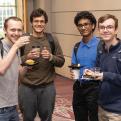
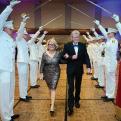
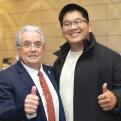
Some individuals have donated unsolicited estate gifts. The largest was from Jon L. Hagler ’58 as part of his signature gift and renaming of the institute. The frst professor to establish an estate gift was Ozden O. Ochoa ‘77, Professor Emerita, Mechanical Engineering. Walter W. Buchanan, professor in the College of Engineering and a graduate of Purdue University and Indiana University, along with his wife, Charlotte, donated their estates to establish a Hagler Chair within the College of Engineering. Elouise and John L. Junkins, Founding Director of the Hagler Institute, have endowed a chair from their estate to support Hagler Fellows in the feld of aerospace engineering. Professor Janet F. Bluemel and University Distinguished Professor John A. Gladysz, holder of the Dow Chair in Chemical Invention, both faculty in the new College of Arts and Sciences, have made provisions in their wills to contribute to the Hagler Institute. Other estate gifts to the Hagler Institute include gifts from Associate Director Cliford L. Fry ’67 and his wife Judy, Roderick D. Stepp ’59, and Christi L. ’98 and Tyson T. Voelkel ’96, plus another from an anonymous donor.
The Hagler Institute was also blessed to receive a gift from the estate of former External Advisory Board member, the late H. Norman Abramson.
The mission of the Hagler Institute has inspired Texas A&M faculty members who
are not former students to contribute support for the institute. Some have walked in unsolicited to the Hagler ofce with a check in hand. Katepalli Sreenivasan and Alan Needleman, from the frst group of Hagler Fellows, have made several cash gifts, as has the Willard and Anne Levin Foundation, thanks to Trustee Terrell Mullins ’67. Advocates Janet and Jean-Louis Briaud have also provided welcome gifts. A number of other donors who wish to remain anonymous have stepped forward to contribute. It is remarkable that none of the gifts to date have been solicited.
Our near-term goal is to fnd one or more additional endowments for the Hagler Institute to support fellows in colleges and schools currently lacking such support, as well as $25 million in endowments for graduate student fellowships. Despite substantial progress, we are still well short of that goal, but gaining momentum. We are pleased that more and more members of the Aggie Network are recognizing the merit and power of investing in the Hagler Institute. Achieving this goal will vastly accelerate every college and school and make Hagler Fellows easily afordable for all disciplines. You can make a diference in the excellence of your department, college, school and Texas A&M.
We would be delighted for you to join us to help elevate Texas A&M in perpetuity.
Fresh opportunities have surfaced in the recent year. The Hagler Institute is managing the new Chancellor’s National Academy STEM Ph.D. Fellowship Program designed to attract more of the nation’s most outstanding graduate students to Texas A&M. The Hagler Institute will be at the helm of connecting these students with Hagler Fellows. The upside impact of this program can only be imagined.
For the life of the university, donors of a cash endowment or a planned estate gift will have their names associated with a series of the world’s most remarkable scholars. Endowed chairs for Hagler Fellows, and endowed fellowships for graduate students to work with fellows, are among the most prestigious on campus. These endowments bear the name of the donor and may be focused for particular colleges, schools, departments or disciplines.
To enhance efciency of the use of earnings, the institute prefers such endowments to be provided to the Hagler Institute. Such funds can be earmarked for particular departments or colleges, but when the Hagler Institute can see the fnancial reports of earnings it can better manage use and ensure the impact of the funds. Fellow recruitment is where our attention is focused, and the Hagler Institute can appropriately encourage nominations for the best possible use of earnings.
Our near-term goal is to fnd one or more additional endowments for the Hagler Institute to support fellows in colleges and schools currently lacking such support, as well as $25 million in endowments for graduate student fellowships. Despite substantial progress, we are still well short of that goal but gaining momentum. Achieving this goal will vastly accelerate every college and school and make Hagler Fellows easily afordable for all disciplines.
Many of us have reached “the prime of life,” that delightful period between 65 and infnity. For those of us also blessed with more than sufcient funds to
live out our days in comfort and then tell our loved ones that we remembered them, the question naturally arises, “How do I best pay forward the blessings that enabled me to prosper?” Upon asking ourselves this question 15 years ago, Elouise and I had little difculty voting with our life savings to help insure the future of this institute. Providing estate gifts and endowments are very personal decisions that refect our circumstances and what we value. They are not to be taken lightly, and I never (explicitly!) ask for endowments for this institute. However, I am deeply grateful and moved whenever someone recognizes the importance of what this institute can mean in so many lives and the excellence of Texas A&M University.
Indeed, we are pleased and blessed that more and more members of the Aggie Network are recognizing the merit and power of investing in the Hagler Institute.
As Abraham Lincoln said, “The best way to predict the future is to create it.” You can make a diference in the excellence of your beloved department, college or school. We would be delighted for you to join us to help elevate Texas A&M University in perpetuity.
FOR INQUIRIES, CONTACT:
Cliford L. Fry
Associate Director
Hagler Institute for Advanced Study cfry@tamu.edu / 979.458.5723 or John L. Junkins
Founding Director
Hagler Institute for Advanced Study junkins@tamu.edu / 979.458.4992
EXCELLENCE TRULY BREEDS MORE EXCELLENCE
JOHN L. JUNKINS
Texas A&M University / 8th Floor, Rudder Tower / 3572 TAMU / College Station, Texas, 77843-3572
hias.tamu.edu